Another good year for Maine tourism
State reports $8.4 billion in spending
BY TOM GROENING
Maine’s tourism economy rarely seems to enjoy a normal year. Factors such as fluctuating gas prices and airline fares, terrorist attacks, and pandemics play their part in either inflating or deflating visitation.
But despite these variables, the numbers make the case that tourism remains a major economic sector in the state. Beyond spending by visitors, tourism officials are now drawing links between those visiting and other economic challenges, such as an aging population and shrinking work force, with the tourism draw holding potential to ease those demographic burdens.
At the annual Governor’s Tourism Conference in Bangor on March 28, officials reported that visitation in 2022 was down slightly from the previous year— from 15.6 million to 15.3 million. But spending was up, from $7.8 billion to $8.4 billion, no doubt tied to broad inflation.
That spending supports 151,000 jobs, officials said, contributing $5.6 billion in earnings to Maine
Kim
Hamilton
households. Restaurant and lodging taxes paid by tourists reduced the tax burden to Maine households by $2,172.
Given the variables in a very competitive environment, the Maine Office of Tourism works on adjusting its marketing strategies to match ever-changing
trends. One constant buoying Maine’s tourism is the rate at which visitors return.
“Their interest in coming back is significantly higher than in other regions,” said Heather Johnson, commissioner of the state’s Department of Economic
continued on page 4
named Institute president
Island, nonprofit background cited as strength
BY TOM GROENING
The Island Institute, publisher of The Working Waterfront, named Kim Hamilton as its president, effective April 1. Hamilton has served as the organization’s

interim chief programs officer since September, overseeing the Institute’s climate, economic resilience, and leadership programs and serving on its senior leadership team.
The Rockland-based nonprofit’s board of trustees cited Hamilton’s
CAR-RT SORT POSTAL CUSTOMER
“strong leadership, mission-driven focus, proven fundraising success, and commitments to Maine’s coastal and island communities” in selecting her for the position.
Hamilton earned a Ph.D in demography from Brown University and a master’s from John Hopkins University. Her professional experience includes a tenure as president of FocusMaine where she led efforts to accelerate job creation in the agriculture, aquaculture, and biopharmaceutical sectors. She has also served as chief impact officer at Feeding America and director of strategy planning and management at the Bill and Melinda Gates Foundation.
Hamilton is originally from North Yarmouth and now lives on Chebeague Island.
She steps into the role as the organization marks 40 years of working to build sustainability in island and coastal communities and sharing solutions for addressing the coast’s most critical concerns.
“During her time as interim chief programs officer Kim has done a fantastic job advancing our work to create a sustainable coastal economy, create climate solutions, and advancing our history of creating leaders for Maine’s coastal communities,” said Kristin Howard, chairwoman of the board of trustees. “We
continued on page 5
NON-PROFIT ORG. U.S. POSTAGE PAID PORTLAND, ME 04101 PERMIT NO. 454 News from Maine’s Island and Coastal Communities published by the island institute n workingwaterfront.com volume 37, no. 3 n may 2023 n free circulation: 50,000
Gov. Janet Mill, left, poses with Paul Coulombe in front of TV cameras at the Governor’s Tourism Conference in Bangor on March 28. Coulombe was honored with the Governor’s Award for Excellence in Tourism for his philanthropy and commercial development work in Boothbay Harbor.
PHOTO: TOM GROENING
“I want us to be known as the organization that fights hard for Maine’s islands and coastal communities.”
—Kim Hamilton
On the record with…
Musician Noel Stookey of Blue Hill

Coming to Maine spurred by Nearings, Gordon Bok
BY TOM GROENING
His given name is Noel, but most over the age of 60 know him as Paul Stookey, a member of the folk music trio Peter, Paul, and Mary, stalwarts of the 1960s, known for covering such songs as “Blowin’ in the Wind” by a then-unknown Bob Dylan, Pete Seeger and Lee Hays’ “If I Had a Hammer,” and of course, “Puff the Magic Dragon.”
Stookey continued to make music with and without his former bandmates, and even at age 84, has released a new album, Fazz: Now & Then, a collection that infuses jazz chords and a beat sensibility to his folk roots. Or maybe the other way around.

Stookey hails from rural Maryland, but in the early 1970s, he chose to settle in coastal Maine, where he and his wife raised three daughters in Blue Hill Falls, a few miles from where E.B. White lived and wrote. He cites the landmark how-to, Living The Good Life, by Scott and Helen Nearing, who later lived in Brooksville, as influencing his search for a rural life. He also espouses Christian beliefs, which has threaded through his music.
Our conversation over Zoom, with Stookey in his Blue Hill home, was edited for length and clarity.
The Working Waterfront: How did you come to live in Maine?
Noel Stookey: We bought a house in New Hampshire, and actually spent about three months there, and just decided that it was too insular. We were fortunate enough to be able to afford to experiment with actual purchases. I think we were still living in Westchester County (N.Y.) at that point. This would have been the early ‘70s. I had just—what we referred to in Peter, Paul, and Mary as “taking time off for good behavior”—I had just gone through such a spiritual change that the only way I could see discovering and defining the clarity of that experience was moving to someplace like the country.
Both my wife and I had been brought up in rural areas. So my experience and reverence for the woods, for the pond that was at the top of the big hill that I would go explore, and my dad’s encouragement, because he was a young man growing up on a ranch in Utah, transmitted that kind of awareness for the personal responsibility for living one’s life, based in natural circumstance. Ultimately, I was in my 30s when I moved to Blue Hill.
WW: When was the first time you visited Maine? Had you toured here?
Stookey: I had gone with my dad fishing here. We had a trailer that we took around a lot. Mom would stay in the trailer and Dad and I would go fishing. Betty, my wife, actually, made annual visits to Ogunquit or Kennebunkport, so she was familiar with Maine from a vacation point of view.
WW: So what were your impressions of Maine then and in the ‘70s?
Stookey: I have to tell you that the background of moving to Maine also included Gordon Bok [the Camden-Rockport-based folk singer], who, coincidentally, we saw just recently in Rockland at the Sail, Power, and Steam Museum.
When Betty and I determined that we wanted to find a place in the country we had an RV at the time, which we used for every conceivable kind of errand, from birthday party pickups to McDonald lunches, to even driving into New York City.
The RV took us up to Nova Scotia, all up the East Coast. One of those trips, when Betty and I wanted to move to the country, was to Camden to talk to Gordon. And he said, “Well, if you’re looking for something on the ocean, you’re not going to find it here or south. It’s all gone. But head on up north and I’m sure you’ll find something.” We drove a circuitous route, just touching the shoreline all the way up to Eastport, and didn’t really see anything that spoke to us until we hit the town of Blue Hill, which was like a scene out of It’s A Wonderful Life with Jimmy Stewart. There was the town hall, there was the hospital, there was the post office. A perfect little town. And has retained, to a certain extent, in spite of the infusion of people trying to escape cosmopolitan consequences of the pandemic, it has maintained a lot of its character, I think to a large extent because of the artists who live here. Rob Shetterly, Richard Kane, the filmmaker, Becky McCall, Gail Page. There are a lot of talented folks here who contribute to the society.
WW: Did your three daughters go to George Stevens Academy in Blue Hill?
Stookey: Initially. In their sophomore years, we thought they should try a prep school. So Kate went to Milton, Anna tried St. Paul’s for one year, but came back to GSA, and commented, publicly and privately, that the instruction was better as George Stevens. And Liz went to Middlesex.
WW: And of course, Kate is now the executive director of Maine Coast Heritage Trust. And looking at that job and that nonprofit, through her eyes and your eyes, what are your views of the challenges that the coast of Maine faces, given what you’ve seen in your time here?

2 The Working Waterfront may 2023
JB Paint Company INDUSTRIAL MARINE COATINGS & SUPPLY Blast Media & Blast Supplies, Sprayers, Sprayer Repair/Supplies... Plus much more... 2225 Odlin Road, Hermon ME 04401 207-942-2003
Noel “Paul” Stookey performing in the studios of WERU-FM (89.9), the community radio station he helped launch in 1988. PHOTO: COURTESY WERU-FM.
Stookey: There is the challenge of maintaining a balance between making a living from the ocean and the shoreline, and conserving the ocean and the shoreline. Kate’s advanced thinking on this is realizing the need for inclusion of all of the aspects of the nonprofits who are concerned with the conservation of resources here in Maine. And some of them are not mainstream. But they should all have access to the information, that it could be shared, and by those means, a stronger case can be made, because it will include more people.


Our first purchase in the town of Blue Hill was a henhouse. Though we made the unfortunate mistake of renting a house from a family called the Coops, which immediately led everyone to believe we were living in the henhouse that we bought, which was abandoned for two or three years.

It came with 47 acres of forest bordering on the Salt Pond which runs behind the South Blue Hill peninsula. Kate had many opportunities during the years and summers that she was here to be at one, in sense, with the surrounds. She was delighted to come back and celebrates the fact that her meetings with the board of directors generally take place in forests or on trails or on the ocean of some donor.
WW: And back to the henhouse: I think it’s fair to say that there would be no WERU-FM without you and David Snyder…
Stookey: And Reg Bennett. Reg Bennett was an ex-cop in Ellsworth, who had a real heart for kids and for some reason or other, was really into recording. I didn’t really have room for him in the studio as an engineer, but he came around the henhouse often enough that when something went wrong with the equipment, you could give it to him and he’d take it upstairs to a little shop, and he’d bring it back fixed.
WW: The radio station, from my perspective, has been a real cultural resource… Stookey: Absolutely.
WW: And I think some of the newer volunteers have no idea about your role in it. Stookey: My role was really more of a funding agent. Reg and I would have some battles. Reg wanted it to be a Christian radio station. And I was holding out for the community radio station.
The manner I’ve approached music since that period of my life when I discovered the divine, and that love, in fact, was the key component of anybody’s happy life. There’s a song on the new album called “Love With a Capital ‘L’” in an attempt to bridge that gap between people’s perception of love between our brothers and our sisters and that larger love which is the image from which we draw our inspiration.
Reg and I went head-to-head on it for a while but he finally acquiesced.
When they brought out the list of call letters that were available there was one that was circled, and the mind just plays intuitive tricks on you, and to see We Are You (WERU). There it was! How could you not?!

WW: Is Maine a friendly place for music, or folk music?

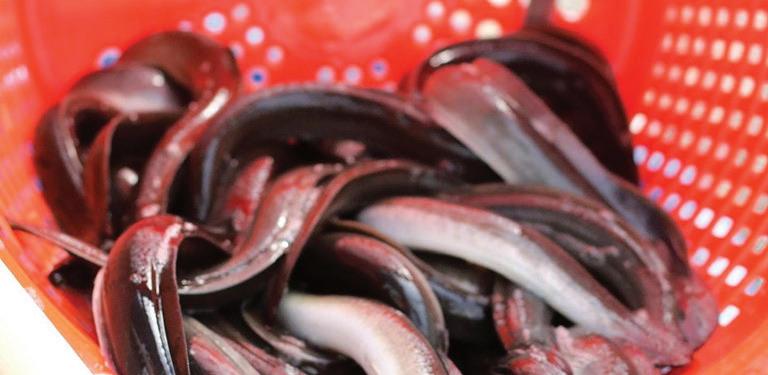

Stookey: I think it’s a little bit of a throw-back. It does hold onto the traditional forms. Which prospers the singer-songwriter more than the rock band. I like the fact that WERU is able to bridge much of that gap [between music styles] by having such a diverse presentation. I particularly enjoy “On The Wing” [an eclectic format]. But they do everything. These are hard times for musicians, no matter what your bent.
I’m in the last phases of a biography that’s being co-written by a woman named Jean Finley. Coming up for a name for the book, we finally settled on Don’t Use My Name because that was the word from the Lord that was given to me at a concert. I was packing up my guitar case and a couple came up to me—this was in England—and I said “Hi,” and they said “Hi,” and they said, “We think we have a word of the Lord for you.” Your heart starts racing a little when people from the outside begin to interfere with your faith. They said, “Don’t use my name. We don’t know what it means, but...”
So, the immediate association is, “Stop preaching. Don’t talk about Me,” with a capital “M,” at all. Or, use parables, dummy. You’re a songwriter. Use metaphor. And that changed my whole writing perspective.
The “Building Block” song, which was the radio station’s theme song for a while, was written sitting on the front steps of the henhouse, looking at the fact that the ice had broken, and was drifting.
“When I am down and unsuspected With a burden that does not show I think what time has resurrected And how the sun can make the water flow.”
WW: Nice.
Stookey: It’s been a good life. And given the enormous blessing of the space that Maine has bestowed on my family, I can’t imagine revising any part of that.
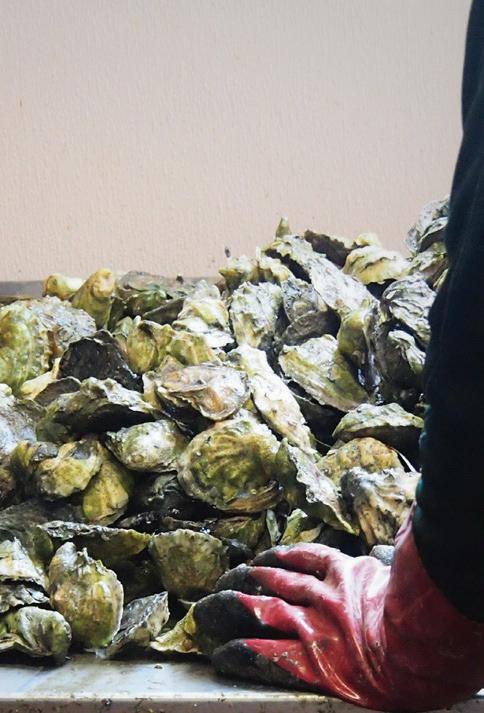
Linkel Construction,


3 www.workingwaterfront.com may 2023 G.F. Johnston & Associates Concept Through Construction 12 Apple Lane, Unit #3, PO Box 197, Southwest Harbor, ME 04679 Phone 207-244-1200— ww w. gfjcivilconsult.com — Consulting Civil Engineers • Regulatory permitting • Land evaluation • Project management • Site Planning • Sewer and water supply systems • Pier and wharf permitting and design
John Martin, Bud Staples, and Elsie Gillespie chat around the woodstove at the annual town meeting.
Gerald “Punkin” Lemoine
Levi Moulden
Sea Farm Loan FINANCING FOR MAINE’S MARINE AQUACULTURISTS For more information contact: Nick Branchina | nick.branchina@ceimaine.org |(207) 295-4912 Hugh Cowperthwaite | hugh.cowperthwaite@ceimaine.org | (207) 295-4914 Funds can be utilized for boats, gear, equipment, infrastructure, land and/or operational capital. Lower Interest Rates Available Now!
Bud Staples
Locally owned and operated; in business for over twenty-five years. • Specializing in slope stabilization and seawalls. • Department of Environmental Protection (DEP) certified. • Experienced, insured and bondable. Free site evaluation and estimate. • One of the most important investments you will make to your shorefront property. • We have the skills and equipment to handle your largest, most challenging project. For more information: www.linkelconstruction.com 207.725.1438
Inc.
TOURISM continued from page 1
and Community Development, which includes the Maine Office of Tourism. Research showed that last year, 32% of visitors had been to Maine more than ten times, and 91% surveyed in 2022 said they would return.
Johnson suggested tourism might be linked to the state’s recent in-migration rate, which was higher last year than any of the other New England states and seventh-highest in the U.S.
With a statewide unemployment rate of just 2.8%, Johnson said, attracting visitors who might become residents is critical to keeping the economy humming.
A couple of themes emerging in the data presented about the industry were the need to appeal to a more diverse population, and that key draws are Maine’s status as a safe, low-crime state with charming downtowns.
“People feel safe to come here and find their futures here,” Johnson said.
How people travel is evolving, she added, and the state’s 2023 tourism marketing plan reflected those changes by adding technical assistance for businesses.
Steve Lyons, director of the Maine Office of Tourism, described 2022 as “a good year,” but a year of transition as the state moved past the COVID pandemic.
In her remarks, Gov. Janet Mills praised the industry—about 350 attended the conference at the Cross Insurance Center—for working to maintain the state’s status as a destination.

“You all worked hard to protect Maine’s reputation as a state to visit,” she said. “You are the face of Maine, making people fall in love with Vacationland.”
Some 47% of visitors surveyed said they noticed the office’s paid advertising with 28% of those reporting they were influenced to visit by those ads, a 9% uptick from the previous year.
Lyons said research showed tourists visit multiple regions in Maine, but 35% said they visited the Midcoast region and
islands, 27% visited Greater Portland and Casco Bay, 27% named Maine beaches, and 25% listed Downeast and Acadia. Other survey data showed that the top reasons given for visiting Maine were to relax and unwind (34%), sightseeing and touring (31%), and visiting family and friends (26%).
Data presented by Downs & St. Germain, a research firm contracted by the Maine Office of Tourism, showed that travel to Maine by those from outside the U.S. grew by 5% over 2021.
Maine residents traveling 50 or more miles for pleasure are considered tourists in the research, and so 19% of tourists started their journeys in the state. Residents of the other New England states accounted for 32% of visitors (14% from Massachusetts), 20% came from the Mid-Atlantic region, 10% from the Southeast U.S., and 4% from Canada.
Emerging markets include Florida, and the Chicago and Atlanta metropolitan areas, which likely would mean those visitors would come by air. Currently, 85% drive to Maine, with just 5% traveling through Portland International Jetport.
Demographic profiling showed that the typical Maine visitor is 49 years old, female (55%), and white (89%).
‘Sea Side Park’ and church
READERS GLEN MAYBERRY of Portland, David Verrill of Scarborough, and Michaeel Percy had information to share about the photo we featured on the op-ed page in the April issue of The Working Waterfront. The photo, which appeared to be from the early 20th century, showed a banner over a street reading, in reverse, “Sea Side Park.” A building at the right of the image was recognized.
“The building in Old Orchard Beach is still there on the corner of Old Orchard Street and Portland Avenue,” wrote Mayberry. “It is now part of St. Margaret’s Catholic Church.”

Verrill wrote that the church is still “serving Mass and performing baptisms, weddings, and funerals. The next building beside it, going down the hill, is St. Margaret’s Parish Hall which has hosted a variety of activities over the years including beano, parish suppers, Christian Doctrine and Catechism classes, meetings of the Ladies Sodality and the Knights of Columbus, and ballroom dance lessons,” he added.
“This photo should evoke many memories for the parishioners and summer visitors to Old Orchard Beach over several generations,” Verrill wrote.
Thanks for your sharp eyes!
Tourism industry honored
Among those honored by the Maine Office of Tourism at the conference were Paul Coulombe, a Lewiston native who sold his White Rock Distilleries in 2012 for $600 million. Coulombe honored with the Governor’s Award for Tourism Excellence for his development and philanthropy work in Boothbay Harbor and Southport.
Also honored were:
• the Schoodic National Scenic Byway committee with the innovative and creative award for developing children-centered signage along the route
• Husson University’s School of Hospitality, Sport, and Tourism Management with the leadership and growth award
• Maine Craft Weekend with the collaboration award.
That typical visitor is a college graduate (77%), married or in a domestic partnership (76%), and has an annual household income of $89,100.
Food and drink were cited by 74% as a top activity, followed by touring and sightseeing (53%), and shopping (50%).
Other key numbers from 2022 reported by Downs & St. Germain include:
• Room occupancy rate—56.1% (up 13.6% from 2021)
• Average daily room rate—$197.84 (up 35.2% from 2021)
• 69% of visitors started planning their trip 51 days in advance
• 66% of visitors considered visiting only Maine (down 6% from 2021)
• Of the 47% who noticed advertising, the top sources were social media (39%), internet (35%), and magazine (21%)
• Typical Maine visitor traveled with 2.9 people in party
• 18% traveled with at least one person under the age of 18
• Typical visitors stayed 4.6 nights
—Tom Groening
4 The Working Waterfront may 2023
Gov. Janet Mills, center, poses with students and faculty from Husson University’s Hospitality & Tourism master’s program.
PHOTO: TOM GROENING
HAMILTON
continued from page 1
look forward to seeing Kim build from this early success in the years to come.”
Hamilton cites her ties to the region in informing her approach.
“As a Mainer and islander, I deeply understand the dynamics of year-round island living and the challenges and opportunities faced by Maine’s islands and coastal communities,” she said. “As Island Institute president, I am honored to step into this role as we celebrate our first 40 years and lay a strong foundation for our future.”
Hamilton agreed to answer questions from the newspaper:
The Working Waterfront: What drew you to the Island Institute?
Hamilton: If you live along the coast in Maine, you’re more than likely to have heard of the Island Institute. That was true for me. It wasn’t until I had the opportunity to step in as chief programs officer, however, that I understood the span of its reach and its extraordinary history.
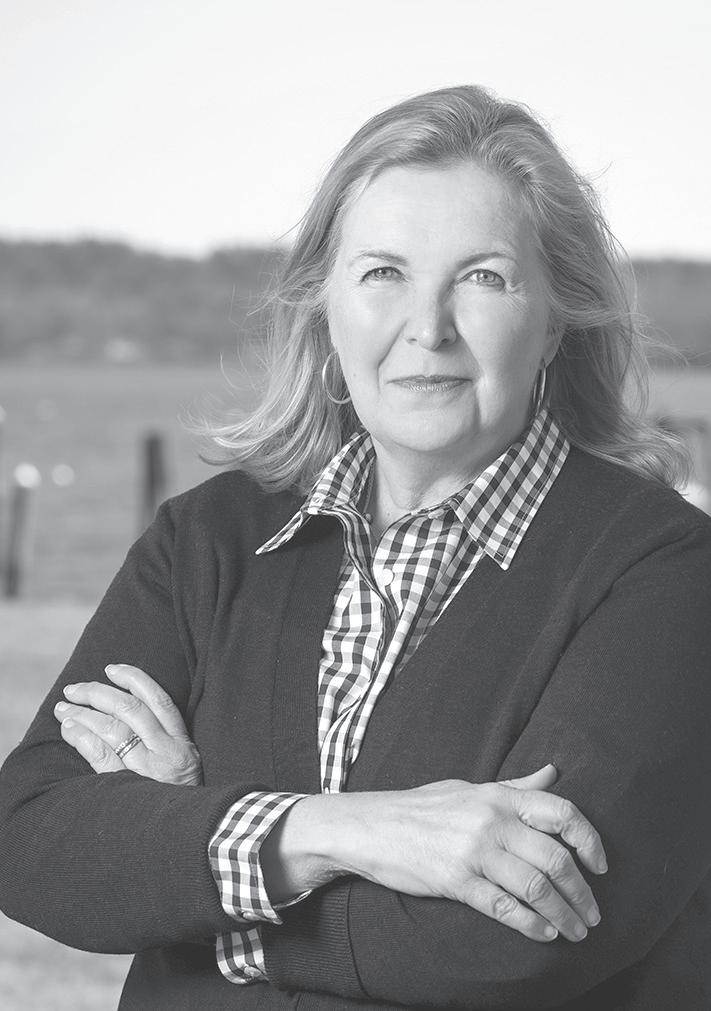
I’ve also come to know and deeply appreciate the people in the organization and their commitment to Maine’s coastal and island communities. I don’t know of a more dedicated team so singularly focused on the future of Maine’s coast.
Now that I live on Chebeague Island where my family has deep roots, I especially appreciate the community connections the Island Institute has cultivated. I know some of the young people who have benefitted from scholarships and aquaculture farmers who have received support. The impact is tangible and real, and with a 40 year history, it spans generations. The opportunity to build on that legacy is exciting.
WW: What has your island experience taught you about how community works, and where and how an outside organization like the Institute can help and support it?
Hamilton: It’s not just an island thing. Every community is different, and has different assets,
opportunities, and challenges. This is as true in Mali as it is on Monhegan. That’s why taking time to build relationships, listen to community members, ask questions, and commit to a long-term partnership is important.
That’s only the beginning. Showing up, delivering on what you promise, and offering practical solutions gets you invited back. It’s a privilege to be invited into a community, and we need to honor that.
WW: Tell me about your professional background.
Hamilton: If you’re looking for a through-line in my career, you won’t find it, except that I’ve always been drawn to organizations that are tackling big challenges—from immigration to food insecurity to job creation in Maine.
I spent many years working in global philanthropy at the Bill & Melinda Gates Foundation and other foundations helping visionary leaders build strong organizations. I’ve learned so much from those experiences about perseverance and vision.
I’m trained as a demographer, which has given me an appreciation of the long-term population trends in Maine and the impact on the state’s economic vitality.
I was drawn back to Maine, however, by the opportunity to launch FocusMaine, a terrific organization working on growing high-growth sectors in the state, like aquaculture. That experience deepened my understanding of the extreme changes facing Maine’s coastal communities and islands as well as the opportunities that are ours to seize.
WW: What are those big issues facing Maine coastal and island communities in the next five to ten years?
Hamilton: It’s a long list. Sea level rise, the warming of the Gulf of Maine, challenges to Maine’s iconic lobster industry, rising housing prices, economic volatility, energy security, and a working waterfront under duress. That’s why we talk a lot about hope and community resilience at the Island Institute.
Communities all along the coast have evolved and responded over hundreds of years. Ingenuity is in our shared DNA, and I don’t believe that will ever change.
WW: How would you like the Institute to respond to these concerns? And how would you like the organization to be understood by the communities it serves?
Hamilton: We’ve worked hard to develop strategies that play to our strengths and respond to community needs, with a special focus on climate solutions, economic resilience, and community leadership. These provide a framework for community solutions, not a prescription.
I want us to be judged by the value we bring, the ideas we share, and the respect we have for the communities that invite us in. I want us to be known as the organization that fights hard for Maine’s islands and coastal communities.
Friends of Acadia purchases inn for housing
IN MARCH, Friends of Acadia became the official owner of the Kingsleigh Inn in Southwest Harbor. Formerly a bed and breakfast inn that housed visitors to Mount Desert Island and Acadia National Park, Friends of Acadia plans to convert the inn to workforce housing for the park’s seasonal employees.
Though Friends of Acadia owns the property, it will be managed and operated by Acadia National Park in similar fashion to existing park housing. The building has eight bedrooms with adjoining bathrooms and a twobedroom apartment, so the plan is to provide seasonal housing for ten employees. The property will remain on the town’s tax roll.
Friends of Acadia has partnered with the National Park Service (NPS) to address the housing crisis on MDI and its surrounding communities. The housing shortage has a direct impact on Acadia’s ability to hire a seasonal workforce to provide a quality visitor experience, care for cultural and natural resources, make progress on diversity and inclusion initiatives, and advance other strategic priorities.
“Seasonal employees are essential to operating and providing visitor services in the park from May to November,”
said Kevin Schneider, Acadia National Park’s superintendent.
“Last year, we were not able to fill all of our available seasonal positions largely because of the lack of housing options in and around Acadia. By expanding housing options, the Kingsleigh property will increase our capacity to recruit and retain seasonal staff members,” Schneider said. “We are incredibly grateful to Friends of Acadia for helping to support this need.”
Purchase of the Kingsleigh Inn falls within one of several strategies Friends of Acadia is taking in partnership with the NPS to expand seasonal workforce housing and address MDI’s housing crisis.
“Our goal is to add 130 new beds over the next decade for the park and its partners,” said Friends of Acadia President and CEO Eric Stiles. “We’ve developed a three-pronged approach that includes adding bedrooms to existing park units, repurposing commercial properties, like the Kingsleigh Inn, and constructing new housing units on sites within Acadia.
The housing crisis is not unique to Acadia National Park. Rather, it’s an issue faced by many parks throughout the National Park Service.
“Supporting our talented and dedicated staff is a key component of fulfilling the National Park Service mission to preserve and protect amazing places like Acadia National Park for the enjoyment of current and future visitors,” said Schneider.

“It will take all hands on deck to provide housing for our workforce
on MDI and surrounding communities. In doing this work, we are not just addressing the housing problem, but also the equity issue. We’re removing a huge barrier to employment and helping to ensure that employment here remains available and affordable to all,” Stiles said.
5 www.workingwaterfront.com may 2023
Kim Hamilton is the Island Institute’s new president.
From left, Dave Edson of Friends of Acadia’s board of directors; Kevin Schneider, park superintendent; Jack Kelley, Friends of Acadia board chairman, and Eric Stiles, Friends of Acadia president and CEO, in front of the Kingsleigh Inn in Southwest Harbor.
PHOTO: GINNY MAJKA/FRIENDS OF ACADIA
book reviews
Fictional drama added to shameful reality
Novel drawing on Malaga Island horrors perpetuates myths
Harding’s stark fictional backdrop of Apple Island is salted by the demands of Maine’s unforgiving coastline and the ever-swirling, multi-generational eddies of mainland malevolence grounded in fear, suspicion, racism, and eventually eugenics. Harding also spices his Apple Island storytelling with allusions to incest and suspicions of murder.
This Other Eden
By Paul Harding
W.W. Norton & Co., 2023
REVIEW BY TOM WALSH
KATE MCBRIEN needs not even ten words to describe her reaction to This Other Eden.
One will do: “Offensive.”
Maine’s state archivist has found getting through Paul Harding’s newest coastal novel something of a challenge.
“It perpetuates all the myths about early Maine history. And none of them are true. That’s problematic.”
The novel’s characters include mixed-race generations of castaways, “queer squatters” living on a very small island amid nearly 100 years of undiluted genetics, with extended families existing hand-to-mouth within a haunting, other-world reality.
That bothers McBrien, who lectures on the history of Malaga Island. The 42-acre Casco Bay Island near Phippsburg was inhabited for more than 100 years by a small, racially diverse fishing community that extended over six generations. Those who lived there were evicted by decree of Maine’s governor in 1912, a process that demolished the homes of 47 residents, including eight inhabitants deemed “feeble-minded” who were then committed to a state institution.
Corpses buried there were exhumed and removed to an on-shore cemetery. To preclude resettlement, the state bought the island for $471. It was acquired by Maine Coast Heritage Trust in 2001 and is now an offshore preserve popular with tourists in kayaks.
“It’s sensationalistic,” McBrien says of The Other Eden. “There was no incest. There were no murders. But I hope at least it sparks interest in the real story because it is an important story of the role abolition, racism, and eugenics played in Maine’s early history.

“Malaga Island was the only Maine community broken up by eugenics, although it happened in other states and to other individuals. I hope at least this book sparks an interest in the real story. Paul Harding has won a Pulitzer Prize, so I suspect that readers might think this is the real story. There is one book now in progress that better reflects Malaga Island history.”
Harding’s debut novel Tinkers is also multi-generational and Maine-based. First published in 2009, it won the 2010 Pulitzer Prize for Fiction.
History aside, Harding’s methods of melding words and his way with characters of his own invention is often stunning, both in concept and execution: “The islanders were so used to diets of wind and fog, to meals of
Class clashes and conspiracy logic
into the community. Their son, Stephen, is born and attends the local elementary school. Enough trust builds up around Walter to get him elected a selectman.
Everyone, however, remains aware of the socioeconomic divide between town and Raths, as evidenced in Stephen’s hilarious, uncomfortable interactions with his little friends from the town’s trailer park.
Land of Cockaigne
By Jeffrey Lewis, Haus Publishing Ltd. (2022)
REVIEW BY DANA WILDE
THE CENTRAL thing you need to know about the protagonist family in Jeffrey Lewis’s novel Land of Cockaigne is that they are from away.

Walter and Catherine “Charley” Rath arrived in Sneeds Harbor, located somewhere along the rim of Mount Desert Island, after Walter had made a ton of money early in the Silicon Valley heyday. They bought a yawl, sailed around, found Sneeds, and decided it was a quaint, remote place to make a home.
A pretty nice home, of course. In their own patient time, the Raths come to fit
Walter hires Donnie Cormer, the father of one of Stephen’s friends, to caretake their home. Donnie is one of those rock-solid, stand-up guys whose integrity quietly keeps small Maine towns running. As time goes by, he remains loyal to the Raths and the Raths to him, even amid the inevitable town chatter about them, some of it warm, some chronically skeptical, some kind of nasty.
Eventually Stephen goes off to college and gets involved in social work. In New York City, a random disaster shakes everything up, launching the main story.
Charley and Stephen’s black girlfriend, Sharon, concoct a plan to build in Sneeds Harbor a sort of glorified summer camp for underprivileged young men from the city. Walter skeptically calls it a “land of cockaigne,” invoking the 16th-century painting
by Pieter Bruegel the Elder depicting peasants lolling in gluttony and satiety. Charley is chafed by Walter’s skeptical irony. And likewise, the possibility of actual cocaine and other defilements infiltrating Sneeds Harbor chafes some of the townspeople, especially those with a disposition to suspect people of color—which the campers are expected to be—of being rife with criminality. A former governor’s actual embarrassing words are put to biting, ironic use in illustration of this.
As the camp takes shape, so do long-underlying frictions between the well-off Raths and the less-welloff locals, as well as between Charley and Walter. The camp’s pros and cons, so to speak, are debated in town gatherings, unofficial and official. Rumor and fear bubble together.
In one chillingly realistic conversation, stolid Donnie is harangued by his buddy Rine, who has been surfing conspiracy-theory websites.
“Where would you guess,” Rine says, “Walter Rath comes from?”
“Michigan.”
“Yeah, but ethnicity. Nationality. What I’m saying, we got a socialistic plot right here in River City. It could be a small part of the enchilada, but it’s definitely a part, one more part, and
slow-roasted sunshine and poached storm clouds, so used to devouring sauteed shadows and broiled echoes.”
Fictional travels through The Other Eden island’s stony woods include a delicate and insightful portrait of a young man as an artist, a boy whose pale-skin and brilliant talent doom him to wander from a cloistered life of island isolation onto the mainland and well beyond, perhaps even as far as the killing fields of the trench warfare French battlefields of World War I. Equally brilliant is Harding’s crafting of intriguingly eccentric Apple Island characters, including a recluse known to the community as Zachary Hand to God Proverbs, age unknown, a master woodworker who lived alone as freezing temperatures would allow in a hollowed out oak tree of his own design. Working by candlelight, Zachary carved scenes from the Bible on the inside of his oak – Samuel beheading Saul, Judas kissing Christ. Before eviction, he cuts his totem down.
Historical fiction? Or Fictional history? Therein find the rub.
Tom Walsh is a retired journalist, academic, and author of Erin’s Hope, a historical novel about Irish rebellion in 1867.
they get enough parts together and that’ll be the ball game. You know who Karl Marx was, Donnie? … Karl Marx was the whole inventor of communism, and he was … a Jew. … And Walter Rath? … Jew.’”
Charley, Rine observes, could be Jew “by proximity.”
Donnie has bitter choices to make between the Raths and his town.
The young men at the camp are mostly black and Latino, and in the latter part of the story we learn as much about several of them as we do about some of the townspeople, amid funny, ironic, and eventually violent events surrounding the camp.
Jeffrey Lewis’s skills as an Emmy Award-winning TV screenwriter translate artfully into a skillful, skating literary voice whose wry tone and quirky diction dance, throughout, on the edge of glibness. But the story nonetheless conveys an accurate feel for the ways values sprung from sharply different means both mesh and clash in small towns like those around MDI and Castine, where Lewis is a part-time resident.
There is plenty for everybody to laugh uncomfortably at in this book.
Dana Wilde is a member of the National Book Critics Circle.
6 The Working Waterfront may 2023
set in Maine airs dirty laundry
Novel
Harding’s methods of melding words and his way with characters of his own invention is often stunning…
Have you seen the Scuttlebutt?
Guide captures nuances of waterfront town
BY TOM GROENING
The phrase “buyer beware” seems inappropriate for someone settling in a pretty Maine waterfront community. But maybe “buyer aware” makes some sense.
After all, if that town has a working waterfront, a newcomer’s expectations may not match reality. Fishermen’s pickups driving by at 4 a.m. in summer. Diesel boat engines firing up a little later. Stinky, dried bait on the dock. Equally stinky lobster gear stacked nearby.
Those pretty fishing boats bobbing at their moorings in golden sunlight at cocktail hour come with all of the above.
Several years ago, Maine Sea Grant produced brochures distributed by real estate agents making those new homeowners aware of what it meant to live in Harpswell and Jonesport-Beals. Now, Maine Coast Fishermen’s Association, Harpswell Heritage Land Trust, the Holbrook Community Foundation, the Harpswell Anchor newspaper and website, and Cundy’s Harbor Library have taken the concept up a notch or two with Scuttlebutt: A Guide to Living & Working in a Waterfront Community.
The 5-1/2- by 8-1/2-inch glossy publication, illustrated with engaging photos and graphics, welcomes visitors and new settlers to Harpswell, which, with 216 miles of shore, has the longest coastline of any Maine town. Other numbers included in the publication are that this town of 5,031 residents is surrounded by 200 small islands (only 94 are named), and that it has 79 commercially zoned wharves. One of the ideas behind Scuttlebutt is that it can be replicated in other waterfront
communities, says Monique Coombs, director of community programs at Maine Coast Fishermen’s Association.
“There’s a lot of changes happening in Maine’s coastal communities because of things like COVID migration, the ability to work remotely, and gentrification,” she said.
“We have to balance these with the culture and industry that has made up working waterfront communities for generations,” she said. “We think helping educate new and summer residents about living and working in a waterfront community allows us to celebrate commercial fishing and mitigate potential future conflict.”
The Harpswell version is fact-filled and makes its points about the salty realities of the town, including defining the terms access, commercial fishing, working waterfront, rights of way agreements, and working waterfront convenants.

“Wharves are beautiful and full of activity, but they can be slippery, rickety, and potentially hazardous,” one page notes. “Forklifts beep when backing up, bait trucks are noisy and smelly, boats have bright lights so they can see and be seen, and things are often moving quickly.
“If you live near a wharf or are just visiting to buy some lobsters, pay attention to what’s going on, watch your step, and recognize that fishermen are working hard to provide the best seafood in the world.”
Scuttlebutt also offers advice on how to “be a good neighbor and steward of the Gulf of Maine ecosystem” by minimizing or eliminating the use of lawn fertilizers and insecticides, cleaning up after dogs, and using rain barrels to conserve well water.
Acadia announces new entrance fees
THE NATIONAL PARK SERVICE (NPS) has approved an increase in the weekly and annual entrance pass fee for Acadia National Park. The fee increase will go into effect on April 1 and is required year-round. The new seven-day entrance fees are as follows:
• private vehicle— $35
• pedestrian/cyclist—$20
• motorcycle—$30
• The annual fee for Acadia is $70
The majority of Acadia’s entrance fee revenue is retained locally to fund the Island Explorer bus system and other projects that directly benefit visitors and protect park resources. The increased fee revenue will allow Acadia to expand Island Explorer service over the coming years to help alleviate traffic and parking congestion and parking in the park, which is a key part of implementing the park’s transportation plan.
The entrance fee increase does not affect commercial entrance fees for businesses operating in the park under a commercial use authorization or the National Parks and Federal Recreational Lands Passes that can be used at Acadia, including the annual, senior, access, 4th grade, military annual, and military lifetime passes.
Visitors under 16 years of age are exempt from paying an entrance fee.
Visitors can also enjoy entrance fee-free days that provide free admittance to all national parks for everyone. The remaining free entrance dates for 2023 are:
• April 22—the first day of National Park Week
• Aug. 4—Great American Outdoors Day
• Sept. 23—National Public Lands Day
• Nov. 11—Veterans Day
Prior to the approval, the NPS solicited public feedback on the proposed fee increase during a 30-day comment period, which closed Dec. 30. The public comments were predominantly supportive of the entrance fee increase. The NPS also consulted with the congressional delegation and other key partners and stakeholders before approving the fee increase.
But it’s not preachy.
The guide also includes recipes for making lobster stock and crab dip, tips for dealing with the salt air, and descriptions of other fisheries. It even directs readers to other nonprofits working to sustain the way of life towns like Harpswell enjoy.
Interestingly, the publication notes that the term “scuttlebutt” referred to the cask of drinking water aboard a ship, the maritime version of “water cooler.”
The guide was created following a series of panel presentations in the fall
of 2021 and spring of 2022, “Living and Working in a Waterfront Community: A Conversation Series.” Coombs says 1,500 copies were printed, though more will be published this summer to distribute to visitors.
Those interested in developing such a guide in their community should contact Coombs at monique@mainecoastfishermen.org. The organization offers to help communities fundraise and produce a similar guide specific to the community. The approximate budget is based on printing; the cost of producing 1,500 was about $2,000, Coombs said.
Trenton wetlands conserved
THE MAINE DEPARTMENT of Inland Fisheries and Wildlife in partnership with the Frenchman Bay Conservancy have won a $1 million grant to conserve 216 acres of intertidal and freshwater wetlands and adjacent uplands in Trenton.
Sen. Susan Collins, the vice-chairwoman of the Appropriations Committee, and Sen. Angus King, the chairman of the Senate National Parks Subcommittee, announced the award.
“Trenton is a beautiful gateway to Mount Desert Island, and protecting its ecological health is critical to the surrounding region, including Acadia National Park,” said Sens. Collins and King in a joint statement. “By preserving more than 200 acres of land, this conservation project will promote coastal resilience, safeguard native ecosystems and wildlife habitat, and provide economic benefits.”
Coastal wetlands are vitally important in protecting from floods, filtering water, supporting recreation and local economies, and providing habitat for fish and wildlife. Despite their importance, there has been a steady loss of coastal wetlands.
The funding was awarded through the U.S. Fish and Wildlife Service as part of $19 million in competitively awarded grants supporting 21 projects in eight coastal states to protect, restore, or enhance nearly 14,000 acres of coastal wetlands and adjacent upland habitats under the National Coastal Wetlands Conservation Grant Program.
The 2023 grants will help recover coastal-dependent species, enhance flood protection and water quality, provide economic benefits to tribes and underserved communities, increase outdoor recreational opportunities, and benefit habitat and wildlife at several national wildlife refuges.
7 www.workingwaterfront.com may 2023
On-demand gear tested off Massachusetts
Lobstermen’s association remains skeptical
BY CRAIG IDLEBROOK

This spring, researchers were given an expanded opportunity to test lobster trap gear that eliminates the need for vertical buoy lines in waters traversed by critically endangered North Atlantic right whales.
Under the direction of NOAA and with permission from the Massachusetts Department of Marine Fisheries, a fleet of ten vessels has been allowed since Feb. 1 to use special on-demand lobster traps in either state or federal waters along the eastern coast of Massachusetts and south of Martha’s Vineyard. The fleet has until the end of April to test the traps in areas that are otherwise closed to traditional lobstering to protect the endangered whales from entanglement.
As of late March, lobstermen have retrieved the traps from the ocean floor 186 times, according to NOAA data. The lobstermen and the researchers are continuing to test the effectiveness of both the on-demand gear and the mapping technology used to find the traps.
In this round of permitted fishing, one focus is ensuring the tracking technology is accurate even when traps are in proximity to one another. Semiretired lobsterman Marc Palombo said this tracking technology recently passed a critical test in federal waters.
“We got another vessel with a satellite with internet on its boat and had it go right next to my boat, and I could see his gear and he could see my gear,” he said. This effort represents the largest chance yet to experiment with the on-demand traps in real world
conditions in New England. For years, researchers have been working to design traps that could eliminate the need for standing vertical lines. Those efforts have met with some resistance, however.
For example, the Massachusetts Department of Marine Fisheries (DMF) denied an application by a group of lobstermen to test experimental gear in 2022. That group did gain an 11th-hour permission from federal regulators to try the gear in lobster harvesting, but only for a few days.
Since then, NOAA’s Northeast Fisheries Science Center received an exempted fishing permit from federal regulators to allow up to 100 fishing vessels to test and improve on-demand gear in a variety of fisheries. Scientists from the center then devised a plan to test the lobster gear in federal waters and approached Massachusetts DMF for permission to fish in state waters just off the coastline. DMF agreed, and both efforts are being directly supervised by NOAA.
In his letter allowing NOAA to set the experimental traps, DMF Director Daniel J. McKiernan did express some skepticism about the practicality of the on-demand traps for coastal lobstering.
“DMF’s view is that on-demand technology works best for those that fish long trawls on the larger vessels in the fleet,” he wrote. “Its applicability and affordability is far less for smaller vessels that fish single traps or short strings of gear in dense gear fields.”
Erica Fuller, a senior attorney for the Conservation Law Foundation, said that even with those doubts, it still made sense for state regulators to greenlight testing near shore, where lobstering activities are at their densest.
“There were some questions about how close can you actually fish this gear to another guy, and those questions weren’t so much being answered in the far offshore,” Fuller said. “While they were trying to get close, those [offshore] trawls are so much longer they’re generally not right on top of one another.”
DMF Director McKiernan is not alone in his skepticism. When asked about the latest round of testing of on demand gear, Beth Casoni, executive director of the The Massachusetts Lobstermen’s Association sent the following statement:

“The Massachusetts Lobstermen’s Association does not support the use of on-demand gear as the economics are not feasible and it will destroy the American lobster fishery.”

For now, Palombo is one of a minority of lobstermen who doesn’t share his colleagues’ pessimism on the evolving technology, and he has been recruiting other Massachusetts fishermen to the effort to test the new traps out. He knows the technology may still be unaffordable at this point for most fishermen, but he says the funding is there to help develop the trap gear, and he’s seen the improvements each year in the experimental gear. People need to remember that it’s a long process to create a new technology, he said.
“I like to use the analogy that we’re the Wright brothers right now,” Palombo said. “They didn’t start out with the F-15 fighter. They were at Kittyhawk, and that’s where we’re at right now. We’re at Kittyhawk.”
8 The Working Waterfront may 2023 A close working relationship with your insurance agent is worth a lot, too. We’re talking about the long-term value that comes from a personalized approach to insurance coverage offering strategic risk reduction and potential premium savings. Generations of Maine families have looked to Allen Insurance and Financial for a personal approach that brings peace of mind and the very best fit for their unique needs. We do our best to take care of everything, including staying in touch and being there for you, no matter what. That’s the Allen Advantage. Call today. (800) 439-4311 | AllenIF.com Owning a home or business on the coast of Maine has many rewards. We are an independent, employee-owned company with offices in Rockland, Camden, Belfast, Southwest Harbor and Waterville. Monhegan Skiffs for Sale 9 1/2ʹ and 11ʹ plywood and lapstrake Starting at $2,300 Call 677-2614 or email director@carpentersboatshop.com 100 N. Main Street Stonington, ME 04681 207-348-3084 Market & Smokehouse Fresh seafood, fish, crab & lobster meat, smoked mussels, live crabs & lobster. Available year-round! Farm-fresh beef & chicken, Maine-made cheese, dips, eggs, and many other items! Open Mon. 10-4, Tue. – Thurs. 10-3, Fri. 10-4, Sat. 10-5 We ship! coldwaterseafoodmaine.com coldwaterseafoodllc@gmail.com
“DMF’s view is that on-demand technology works best for those that fish long trawls on the larger vessels…”
Immigration lawyer offers Maine perspective
Terminology, facts shed light on realities of issue
 BY STEPHANIE BOUCHARD
BY STEPHANIE BOUCHARD
Immigration law is surrounded by politics, controversy, and debate and is constantly in flux, Jennifer Atkinson told a small audience at Skidompha Public Library in Damariscotta in March.

“It’s very political,” she said. “Depending on the administration, you can see huge changes in what you’re doing and what you have to pay attention to.”
As a state that historically has not seen large influxes of immigrants, the immigration debate has not had the same urgency here as it has in places such as along the southern border, but with asylum seekers coming into the Portland area in numbers the metropolitan area is struggling to manage, immigration issues are on the minds of Mainers.
In order to provide some insight into the complexities of immigration in the U.S., Atkinson, an immigration lawyer at Gallagher, Villeneuve and DeGeer in Damariscotta, presented an immigration law primer as part of the Chats with Champions lecture series.
She did not delve into the current asylum seeker influx to Maine or the ways in which immigration law intersects with international human rights law. But she did highlight a number of things that often are not discussed around the kitchen table or in media reports, such as:
Who exactly is an immigrant?
An immigrant is a person born abroad who is living permanently in the U.S. Someone who is born abroad but is living temporarily in the U.S. is not an immigrant. Undocumented immigrants are people born abroad who are living in the U.S. but who entered the U.S. without proper documentation, such as a visa. Only people from abroad who are lawfully living in the U.S. as permanent residents can naturalize and become citizens.
The U.S. applies different standards for those entering the country.
Unlike other countries, Atkinson said, the U.S. operates on the basic assumption that if you are coming here, you’re doing so to stay.
a matter of going online and applying under the Visa Waiver program.
But for people from places such as Guatemala, there is no easy online process. These people must make an appointment with the U.S. Embassy to persuade an official there that they don’t want to live here permanently. That official has full discretion as to whether to approve the person applying for entry or not.

“If you’re from a less-developed country, it becomes much more difficult to come to the United States as a non-immigrant,” Atkinson said. The hoops to go through to become a permanent resident are even more strenuous and are partly restricted by quotas. Other restrictions can include national security, morality (criminal activity, for example), public health, and flatout racism and xenophobia (the Chinese Exclusion Act of 1882 and the more recent Muslim ban, for example).


As the so-called land of opportunity, the U.S. is a popular choice for migrants.
The U.S. accepts more immigrants than any other country, and businesses are “clamoring” for more workers from abroad, but with so many people wanting to move here, a “broken” immigration system, the lasting impact of the pandemic, and staffing shortages, the backlog of people waiting to get here is enormous, said Atkinson.
“If you are a U.S. citizen and you have a brother or sister in another country and you would like to help them come to the United States, you’re allowed to do that and they can get approved on that basis,” Atkinson said. “However, they’re going to have to wait 16 years for a visa.”
The wait can be even longer if the person is from a country such as India or China. And the immigration process is not cheap, she pointed out.
As of 2018, 4% of Maine residents are immigrants, Atkinson said, with the bulk of those people coming from Canada.
“If you are someone who wants to come here to visit or to study or work temporarily, you have to prove that you are not coming to stay here permanently,” she said.
Proving your intention is easier for people from certain places in the world, she said, for example, places such as Sweden, France, Australia, and New Zealand. For people from these places, it is often just

“U.S. Citizenship and Immigration Services is a fee-based organization, so the fees that they raise pay for them,” she said.
If someone is a foreign national already residing in the U.S., married to a U.S. citizen, the cost of filing fees alone will be around $2,000, she said. For certain types of cases, people can pay an additional $1,500 to $2,500 to expedite the process, she noted.
Maine has never had a large immigration population.

As of 2018, 4% of Maine residents are immigrants, Atkinson said, with the bulk of those people coming from Canada. Nine percent of that 4% are undocumented.

“The undocumented people I have met here in Maine,” she said, “have all been European.”

9 www.workingwaterfront.com may 2023 156 SOUTH MAIN STREET ROCKLAND, MAINE 04841 TELEPHONE: 207-596-7476 FAX: 207-594-7244 www.primroseframing.com G eneral & M arine C ontraC tor D re DG in G & D o C ks 67 Front s treet, ro C klan D, M aine 04841 www pro C k M arine C o M pany C o M tel: (207) 594-9565 National Bank A Division of The First Bancorp • 800.564.3195 • TheFirst.com Member FDIC • Equal Housing Lender DREAM FIRST 43 N. Main St., Stonington (207) 367 6555 owlfurniture.com A patented and affordable solution for ergonomic comfort Made in Maine from recycled plastic and wood composite Available for direct, wholesale and volume sales The ErgoPro 43 N. Main St., Stonington (207) 367 6555 owlfurniture.com A patented and affordable solution for ergonomic comfort Made in Maine from recycled plastic and wood composite Available for direct, wholesale and volume sales The ErgoPro
Advertise in The Working Waterfront, which circulates 45,000 copies from Kittery to Eastport ten times a year. Contact Dave Jackson: djackson@islandinstitute.org
Full Service Boat Yard, Repairs, Storage & Painting P.O. Box 443, Rockland, ME • knightmarineservice.com 207-594-4068
Jennifer Atkinson
rock bound
Remembering conflict on the home front
War’s misery ripples out far and wide
BY TOM GROENING
MEMORIES OF long-ago events are cemented into our hearts and minds when they are baptized in emotion. Where were you when…? Without a visceral response at the “what,” the exact “where” gets fuzzy.
With other big news events in recent weeks—another school shooting, the legal woes of an ex-president—an important anniversary may have been overlooked, but it’s been 20 years since the U.S. under President Bush invaded Iraq.
I have a powerful memory of the day Congress voted to authorize that invasion, and it’s marked by an odd trio of images—bicycle locks, an elevator, and the Marx Brothers.
The Bangor Daily News sent me to cover a protest at then-Sen. Olympia Snowe’s office in Bangor as the drum beats built toward the invasion. I think a half-dozen folks had entered Snowe’s office, without being unduly disruptive, and demanded to speak to the senator before she voted. The long-time office manager—a woman I knew slightly—said she would pass on the message to Snowe’s Washington D.C. office, but suggested a phone conversation was unlikely.
The protestors sat on the floor in the small office, and after a couple of hours, three of them—all in their 20s, as I remember it—took those long U-shaped bicycle locks, put them around their necks, connected them to each other, and locked them. The protest had suddenly ratcheted up a notch.
I sometimes wish I could be a more dispassionate observer, but that’s not my make-up. At one point, as the group lay about on the floor of the small office, the manager didn’t lift her leg quite high enough to step over someone, and inadvertently kicked a protestor, though ever so slightly.
The protestors, well, protested, somewhat angrily.
I knew that the office manager had a degenerative nerve disease that no doubt made stepping over them difficult. I quietly told one of the protestors that fact about 15 minutes after the incident.
I could feel the emotions rising in me. I dreaded what the invasion would bring. Nothing happens in a vacuum; the Bush war had philosophical ties to the 9/11 attacks. Those attacks had their genesis in U.S. dealings with the fighters driving the Soviets out of Afghanistan, effectively abandoning them after the Soviet withdrawal.
reflections
Back in Bangor, the office was preparing to close at 5 p.m. The protestors refused to leave. Police were summoned. Officers were gracious and professional, giving the protestors time to consider leaving before arrests would be made. Most accepted that offer.
The three young adults linked by the locks quietly conferred with each other and agreed to not produce the keys. A locksmith was called. As he gestured and touched the upper chest of one of the women, showing where he would cut the lock, a woman officer scolded him, warning him to keep his hands clear.
Finally, the locks were cut, the three were handcuffed—if memory serves, zip ties were used—and refusing to walk, they were dragged to the elevator door. It was time for me to leave to write my story. As I walked out, the youngest of the three—a woman— was lying on her back, alone, by the elevator, handcuffed.
Her eyes met mine, and I saw fear and the beginning of tears. My tears were on their way, but I held them until I was in my car.
At home that night, I asked the family to join me in watching Duck Soup (1933), the brilliant Marx Brothers
Hearing stories of love and loss
The past has an enduring power
Reflections is written by Island Fellows, recent college grads who do community service work on Maine islands and in coastal communities through the Island Institute, publisher of The Working Waterfront.
BY OLIVIA JOLLEY
BEING A “person from away” is not a new experience for me. I was born in the Southeast where my parents’ family roots lie but I moved to Southern California before I could develop my own Southern twang.
I listened to my parents’ stories, visited my grandparents every summer, and learned how to make my Great Granny’s chicken and dumplings. But living across the country I didn’t know much about my family or their history.
As an Island Fellow, I moved to Swan’s Island for two years to work with the Swan’s Island Historical Society on various projects—saving a church building from the 1800s, digitizing archives and curating exhibits, and being an extra set of hands for whatever tasks arose at the volunteerled organization.
Swan’s Island astounds me because everyone I’ve encountered seems to agree that knowing who and what came before you is important. There is a reverence here for preserving the past and savoring the present that I haven’t experienced anywhere else.
People live and die here. Generations of their family have cultivated the culture and community of this island. The soil is steeped in a history that lives on through the people who stay. It’s not just an island, it’s their island.
I thought I knew the value in preserving and sharing history, but my first few months on this island showed me that my appreciation and understanding of the past were just budding.
It has always been hard for me to connect to stories focused on people. I gravitated towards periods of time, events with impacts spanning the globe, and traditions that endured centuries while people came and went. People were always a part of the story but never the focus, the part that kept my attention.
Through my work with the Swan’s Island Historical Society, I’m starting to see that those individual experiences are not just a piece of the larger picture, a means to an end.
Working with the collections of old family photos has taught me the most—portraits of stern-faced men and women from the 1800s, candid shots of fishermen of all ages buzzing around wharves, and glimpses of the little things that make life different out here.
One photo has been stuck in my head for months.
Two boys sitting in front of a Christmas tree dripping with tinsel and surrounded by their new toys. Their father stands in the doorway, leaning against the frame and looking at his sons with the softest smile. I can’t help but wonder if the person behind the camera saw his smile, too.
I’ve never met the man or the boys, but I’ve cried for them, looked at their
satiric comedy about war (“To war! To war! Freedonia’s going to war!”).
I wanted my teenaged kids to have a good film education, and of course the Marx Brothers were an essential part.
But it is a satiric film. Groucho and his brothers were in their 30s and 40s when the film was made, and they would have known men who had died or were maimed in the Great War that ended 15 years earlier. The cause of that war still is barely understood, which would not have been lost on those seeing the film and Groucho’s insincere outrage over the perceived slight that triggers the movie war.
My anguish, and the plight of the protestors, pale in comparison to the young men and women in Iraq who were killed, or who walk around today missing a limb or an eye, as well as the young Americans asked to serve in the conflict. We need to count the cost. War is no laughing matter.
Tom Groening is editor of The Working Waterfront. He may be reached at tgroening@islandinstitute.org.

faces fondly as if they were my own flesh and blood. I’ve seen their relatives who haven’t walked the earth for decades grow like weeds with their brothers and sisters, go to war and not always come back, and spend their last years at home on Swan’s Island.
These human stories might feel mundane to those living them but they have the power to captivate others, to pique curiosities and shift perspectives.
Stories of love and loss, community and kindness, empower folks to reflect on their own lives, introduce them to different ways of living, and help find common ground and connect with others.
Olivia Jolley works with the Swan’s Island Historical Society digitizing its artifacts and archives. Born in North Carolina, Jolley grew up on the coast of southern California and moved to Maine to attend College of the Atlantic.

10 The Working Waterfront may 2023
There is a reverence here for preserving the past and savoring the present…
BEACH TOWN—
The town of Lincolnville, just north of Camden, has two villages: the Center and the Beach. This image of the Beach, circa 1948, looks remarkably similar to a contemporary view. Most, if not all of the buildings visible here remain, though the business names have changed. The second building from the left has a sign reading Nichols Garage. To its right is the Village Store, which has remained a store to this day. To the right of the store is the post office. In the last 20 years, a new post office has been built a hundred yards or so to the south.

The following was released by Maine’s congressional delegation and Gov. Janet Mills:
SEVERAL YEARS AGO, when NOAA began working on regulations that drastically affect Maine’s lobster fishery without meaningfully advancing the stated goal of protecting endangered right whales, the five of us pledged that we would pursue all policy solutions to protect our hardworking lobstermen and women.
The inclusion of provisions in the federal omnibus funding bill that postpones the implementation of any new whale rules by NOAA for six years is a down payment on that pledge. Working together in a nonpartisan spirit and across levels of government, we achieved a victory for our state, for our iconic and vital lobster industry, and for common sense.
While we are proud of this accomplishment, the resilience shown by the men and women of the industry was our inspiration. In the face of misguided threats to their livelihoods and their way of life, they responded with determination and facts. The expertise provided by the Maine Department of
Island Institute Board of Trustees
Kr istin Howard, Chair
Douglas Henderson, Vice Chair
Charles Owen Verrill, Jr. Secretary
Kate Vogt, Treasurer, Finance Chair
Carol White, Programs Chair
Megan McGi nnis Dayton, Philanthropy & Communications Chair
Shey Conover, Governance Chair
Michael P. Boyd, Clerk
Sebastian Belle
David Cousens
Michael Felton
Nathan Johnson
Emily Lane
Bryan Lewis
Michael Sant
Barbara Kinney Sweet
Donna Wiegle
John Bird (honorary)
Marine Resources, Maine Lobstermen’s Association, and Maine Lobstering Union was essential to this process.
Our provisions mean that for the next six years, the current right whale regulations will be frozen in place, allowing more time to gather data to pinpoint what is causing the demise of the right whale.
It is a measure to protect the family businesses of the thousands of Mainers who make their living from one of the best managed and sustainable fisheries on earth. It also gives the industry and regulators time to develop effective and practicable policies regarding fixedgear fisheries and marine mammals. Without this provision, an industry that contributes more than $1 billion annually to Maine’s economy and supports small businesses all along our coast could have been faced with a complete shutdown, and the ripple effects across our state would have been widespread.
Maine lobstermen and women have long demonstrated their commitment to maintaining and protecting their sustainable fishery. They have invested in countless precautionary measures to protect right whales, including removing more than 30,000 miles of line from the
water and switching to weaker rope to prevent whales from being entangled. And the fact is, there has never been a right whale death attributed to Maine lobster gear. We know the right whale population can be protected along with a thriving fishery because Maine lobstermen and women are already doing it. This industry has a longstanding ethic of practicing sustainability by protecting the health of the lobster stock, and also by treating the entire marine environment with respect and care. The industry recognizes the precarious situation of the North Atlantic right whale, and for decades has been proactive in ensuring that the fishery and the whales can co-exist.
In addition to postponing the implementation of additional regulations for six years, the provision in the funding bill provides $20 million for a grant program that could fund innovative gear technologies and the monitoring necessary to support the dynamic management of fisheries. Fishermen and other participants within the maritime industry would be among those eligible for this funding. Another $22 million was provided for additional research and monitoring efforts for
THE WORKING WATERFRONT
Published
All members of the Island Institute and residents of Maine island communities receive monthly mail delivery of The Working Waterfront.
For home delivery:
right whales, so any future regulations would be informed on real data, not hypotheticals. We also secured an additional $10 million for states to provide direct payments to lobstermen and women to offset the costs associated with the gear modifications that they have made over the past several years.
The lobster industry is Maine’s economic engine, sustaining not only the men and women who fish but entire communities. Fishermen are willing to make changes to proactively protect whales and have been active participants in the ongoing discussions, but Maine’s lobster industry is not to blame for the decline in the right whale population.
Before any additional regulations are implemented, lobstermen deserve to know that these measures are backed by sound science. As this process moves forward, we will continue working together to push for reasonable solutions that protect Maine’s vital lobster industry and safeguard right whales and other marine mammals.
Editor: Tom Groening tgroening@islandinstitute.org
Our advertisers reach 50,000+ readers who care about the coast of Maine. Free distribution from Kittery to Lubec and mailed directly to islanders and members of the Island Institute, and distributed monthly to Portland Press Herald and Bangor Daily News subscribers.
To Advertise Contact: Dave Jackson djackson@islandinstitute.org 542-5801
www.WorkingWaterfront.com
11 www.workingwaterfront.com may 2023 op-ed
by the Island Institute, a non-profit organization that works to sustain Maine's island and coastal communities, and exchanges ideas and experiences to further the sustainability of communities here and elsewhere.
386 Main Street / P.O. Box 648 • Rockland, ME 04841 The Working Waterfront is printed on recycled paper by Masthead Media. Customer Service: (207) 594-9209
Join the Island Institute by calling our office at (207) 594-9209 E-mail us: membership@islandinstitute.org • Visit us online: giving.islandinstitute.org
Submitted by Sens. Susan Collins and Angus King, Reps. Chellie Pingree and Jared Golden, and Gov. Janet Mills.
Delegation, governor inspired by lobster fishery Regulatory ‘pause’ product of cooperative work
Like no other



provisions
Garden & Market
Over 100 Maine Craft Beers, Kombuchas, and Ciders
• Freshly made sandwiches & salads
• Hot entrees: soups, chili, and chowders

• Large selection of wine, craft mixers, and Naut-E botanical spirits




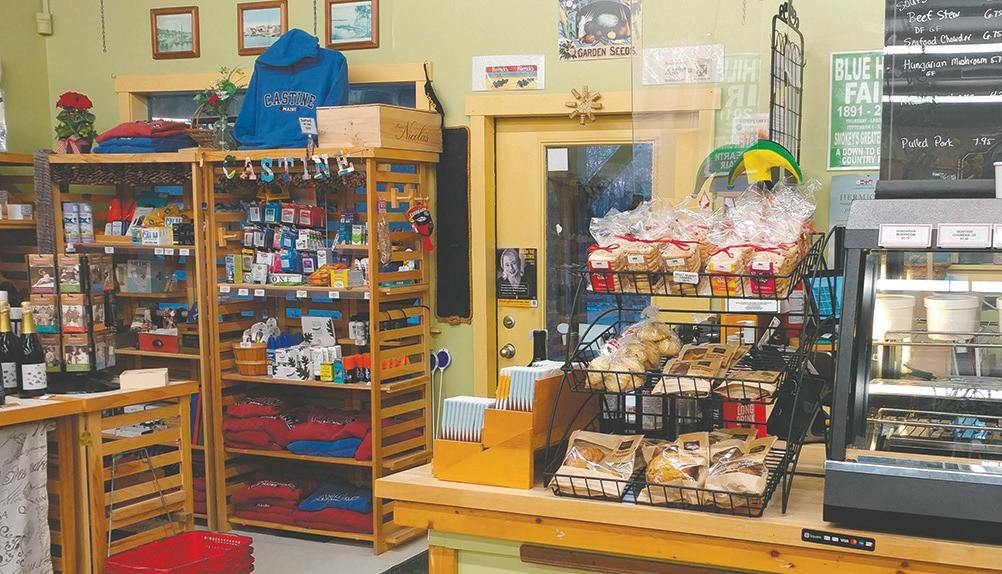
We also have wonderful unique gifts, from finely crafted Japanese teacups, award-winning Folkmanis puppets, and our iconic coffee mugs and sweatshirts—this year’s line being in Pantone’s 2022 color of the year, Peri.

Open Daily 10-5


5 Castine Road • Castine, ME windmillhillprovisions@gmail.com

12 The Working Waterfront may 2023
PHOTOGRAPHS AND ESSAYS by David Owen will be on display at the Fifth Maine Museum on Peaks Island from May 26 to Oct. 9 in a show called “Peaks—Like No Other Island.”
CASTINE MAINE
On Rt. 1 in the Village of Hancock, ME, on just under an acre, this commercial building houses a wine shop, a seafood shop, a dog grooming shop, each of which have been updated, and an empty space ready for a tenant’s business. The wine shop is charming with incredible wine selections and a one-bedroom apartment above with beautiful views to a farm behind the building. Lovely village, close to beaches, docks and hiking trails, halfway between Acadia National Park and the Schoodic branch of Acadia. Live above your business, with lots of possibilities for your ideas and a beautiful space in one of the most traveled corridors of Maine highways. $499,000


TACY RIDLON
(207) 266-7551


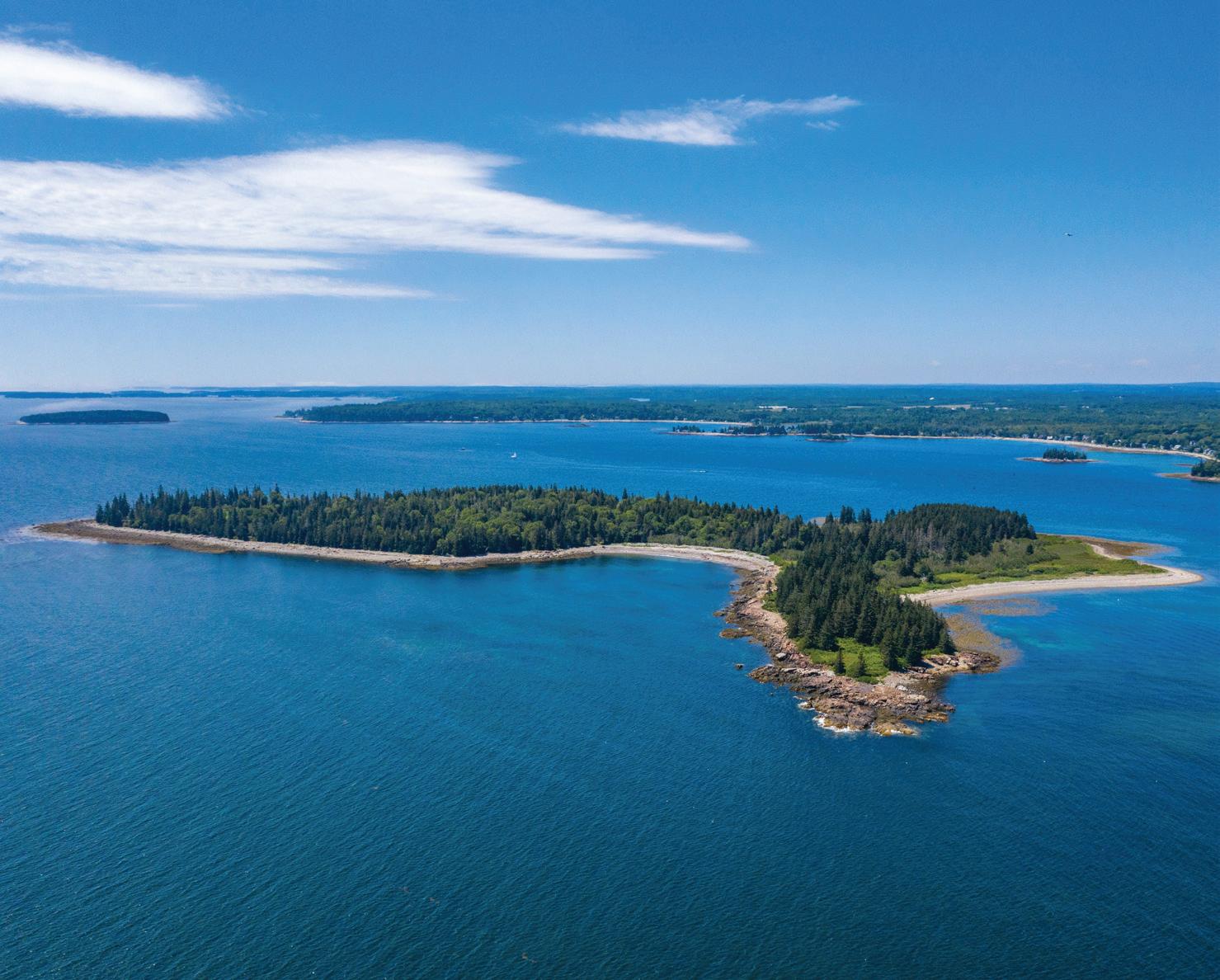
TACYRIDLON@MASIELLO.COM



13 www.workingwaterfront.com may 2023 www.landvest.com Camden: 23 Main Street | 207-236-3543 Northeast Harbor: 125 Main Street | 207-276-3840 Portland: 36 Danforth Street | 207-774-8518 HQ: Ten Post Office Square Suite 1125 South | Boston, MA 02109 If you are Buying We offer spectacular properties for sale throughout New England and beyond If you are Selling We understand Maine’s waterfront and can help you achieve your property’s best value whether it’s a marina, boatyard, land or luxury estate If you need Consulting We provide land planning, appraisal, and project management for significant real estate assets If you invest in Timberland We lead the nation in the marketing and sale of investment timberland properties
traveled the back roads, we’ve navigated the waters, and we know Maine.
We’ve
That ‘other’ Portland
Photographer visits Portland, Oregon’s waterfront


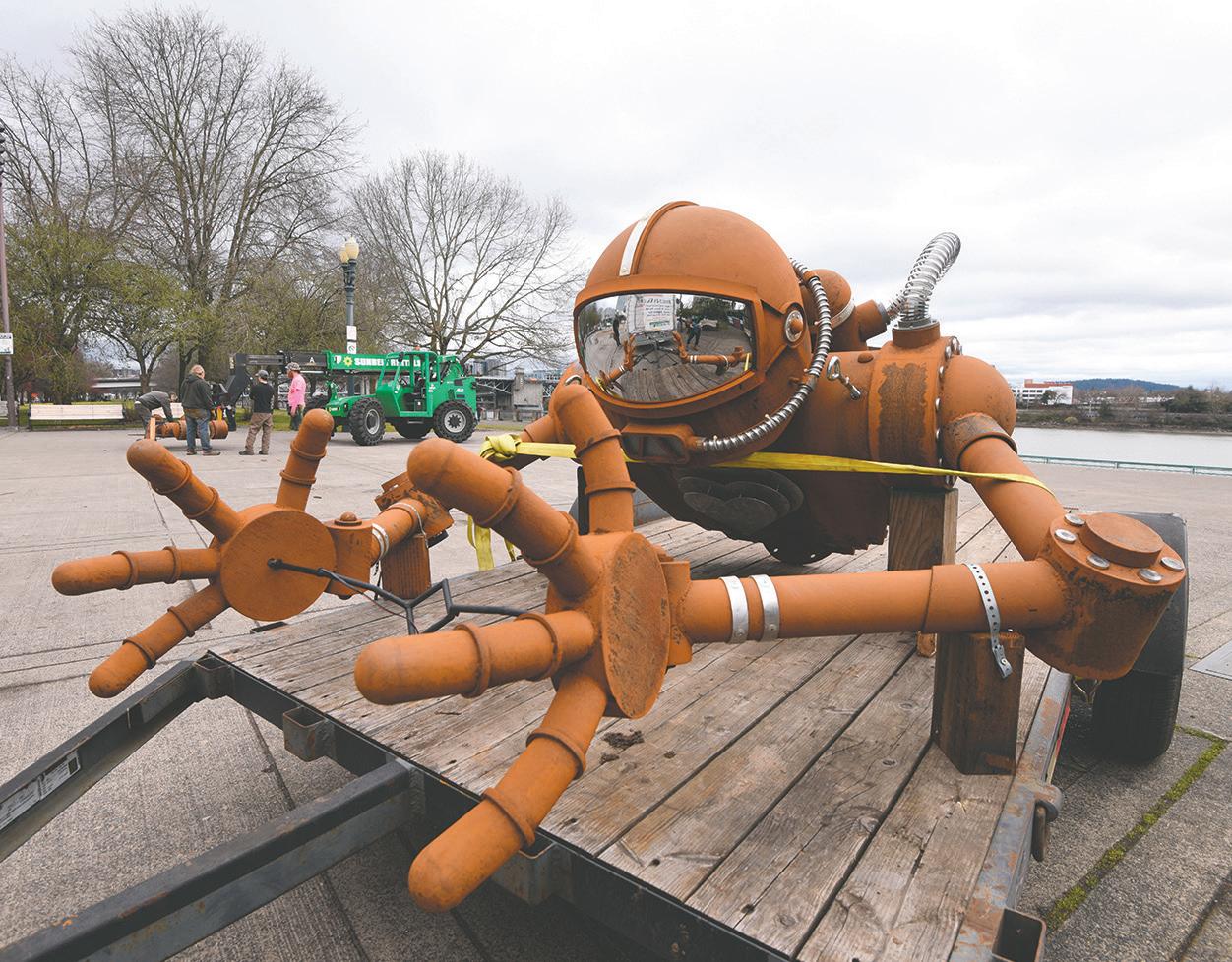 PHOTO ESSSAY BY KELLI PARK
PHOTO ESSSAY BY KELLI PARK
Photographer Kelli Park visited Portland, Oregon recently and documented that city’s waterfront. The city of 641,000 (almost ten times the size of our Portland) has its share of high-rise office buildings, but Park says she was struck by the number of food trucks, live music venues, and restaurants.

“The waterfront was interesting,” she writes “because it was very industrial in some areas, but then it had a really nice park/ green space that ran the length of downtown. The marina downtown was home to a lot of boats that had seen better days,” and little evidence of commercial fishing.
Nine bridges cross the Willamette River in Portland, making that area busy with traffic, she reports.
The cherry trees began to blossom the day she departed.
14 The Working Waterfront may 2023

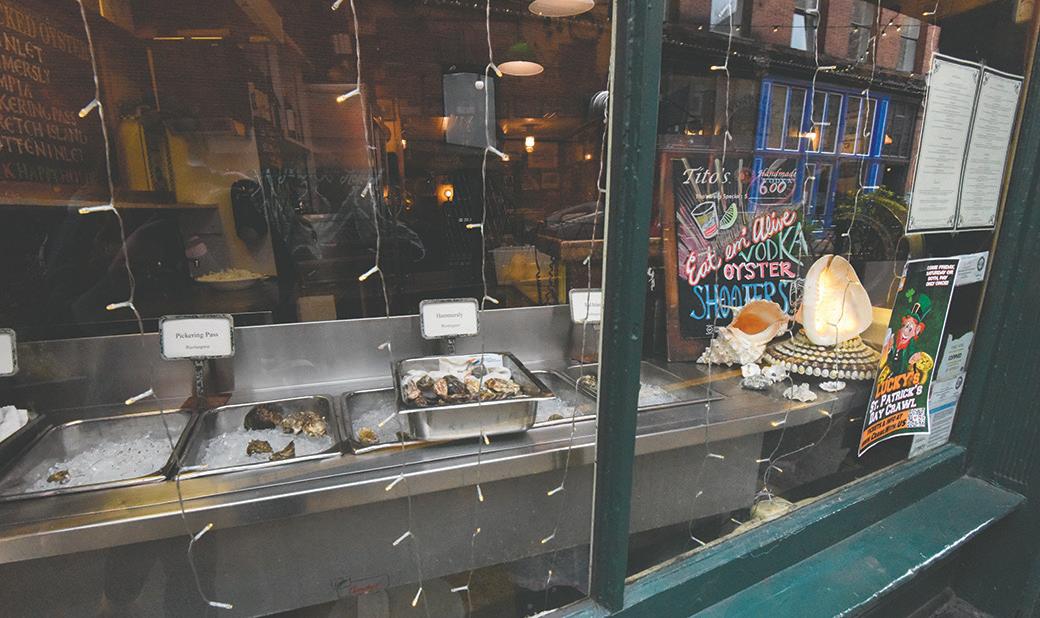



15 www.workingwaterfront.com may 2023
Our Island Communities
Islesboro student flying solo at 16
Jack Moore will soon have pilot license
BY TOM GROENING
Living on an island and relying on a ferry to get to the mainland and the wider world might inspire a young person to seek other modes of transportation. But for Jack Moore, 16, pursuing an airplane pilot license seems to spring from something more profound.





“It was kind of a fascination with all things flying,” he explained in a recent phone interview. “Even birds.” Of course, flying in a small Penobscot Island Air plane with the late Kevin Waters at age 11 also fueled the passion.
“I was hooked from then on out,” Moore says. Moore lives with his father, Terry Moore, on the island where he is a junior at Islesboro Central School, and also with mother, Avery Larned, at her home in Belfast.
He began taking flying lessons at age 15 from Dave Aldrich, a certified instructor, using Belfast’s airport as a base.
“I didn’t really have a goal, a plan,” Moore recalls, and when Aldrich traveled to Florida for the winter,
“I was looking for something more permanent.” He found that at Penobscot Island Air’s flight school in Owls Head, which includes five weeks of classroom time.
“I started to realize I wanted to do this as a career, and get a license as quick as possible,” he explained. Now, he’s about ten hours of flight time from earning a private pilot license.

Even though he doesn’t have that license yet, Moore has “soloed” many times. Those flights bring home the full nature of the experience.
“You can definitely appreciate the technical skill needed to fly the airplane,” he says, especially when the weather is rough. “Taking off is optional,” he says, invoking the pilot’s creed. “Landing is required.”
Yes, there is inherent danger, but “It’s really never the airplane that fails,” he asserts. Almost all crashes come from human error. Moore admits to having “messed up radio calls, using the wrong frequency,” and once flew a little too close to a jet.
“The most important thing you can have is leeway” for those moments, he says.
The joy comes in the “complete and utter freedom”
of traversing the open sky, flying at 3,000 feet and passing beneath a flock of birds, he says.
The only time he confesses to being nervous in the air was on a glider flight with Dave Miramant, a former commercial airline pilot. In fact, Moore says, he was “very nervous” about relying on the vagaries of wind and updrafts to return to the airport.
He’s flown to and from Islesboro’s small paved airstrip and North Haven’s packed dirt strip, along with Owls Head and Belfast.
“It’s been kind of my dream to fly bush planes in Alaska,” he says, but that goal is evolving, and Moore is now thinking about colleges that offer aviation studies with the idea of working for a larger company. A commercial license would allow him to carry paying passengers, and given that a small plane might cost $50,000 to purchase, that revenue appeals to him.
Moore’s mother reports that her son has inspired her to begin her own flight training, and she shares photos she has taken from riding with her son over Eagle Island, where the family lived and worked for most of the children’s early years, running the mailboat.
16 The Working Waterfront may 2023
Eleven-year-old Jack Moore flies with the late Kevin Waters of Penobscot Island Air. PHOTO: COURTESY AVERY LARNED
Moore banks the plane. PHOTO: COURTESY AVERY LARNED Jack Moore after his first solo flight.
PHOTO: COURTESY AVERY LARNED
Moore wearing what are known as “foggles,” which simulate conditions under which a pilot must rely on instruments. PHOTO: COURTESY AVERY LARNED
Moore flying back to Owls Head.
PHOTO: COURTESY AVERY LARNED
The island grocery’s essential role
New owners on North Haven to feature local fare
BY COURTNEY NALIBOFF
Buying groceries is always on the minds of islanders. Mainland trips often end with a carload of fresh fruits and vegetables and specialty items. Planning meals ahead becomes paramount. And the island store can be both a lifeline and source of anxiety.
The “For Sale” sign at North Haven Grocery and Inn was a source of anxiety for residents who often make the 12-mile trip to the mainland to stock up but rely on the store for last minute purchases, non-perishables, and coffee breaks. For Laura Doran and David McDougal, it was also a surprising source of inspiration.
The couple, who had been living and working on Nantucket for several years, connected with the Maine islands through visits to Deer Isle and Vinalhaven.

“On our way back from Deer Isle we stopped on Vinalhaven one year and met Kris Davidson,” Doran said.
“We felt like we had met this amazing person we wanted to be friends with,” said McDougal. After the popular Vinalhaven restaurant Salt closed, Doran and McDougal considered starting a business there, but said no well-suited properties became available.
“In July I saw the [North Haven] store came on the market and in August David and I talked about it,” said Doran. “I was like, ‘Let’s just go see it when we’re heading up to Deer Isle at the end of September. If we’re meant to see it, it will still be there.’”
That the store and inn were still available was the first of three affirmations that the transition was meant to be, McDougal said. The second came when they visited the island in the fall and winter to assess the feasibility of the purchase and renovation of the business.
“Our first instinct was that it was a lot, it was a big task, that maybe it was too much to take on, but our second trip here we met so many amazing people who offered support and help and kind of talked us off the ledge,” said McDougal.
The third affirmation was the preschool, K-12 school, and the community itself.

“The stars aligned. It’s something we want to do, it’s something the community wants to do, and it’s an amazing community to raise a family in,” McDougal said.
Once the decision was made, McDougal and Doran got support from the Island Institute, the Maine Small Business Center for Development, and CEI to secure financing and begin the extensive renovations to ensure the longevity of the store and inn.
The floors have been redone, some interior walls have been taken down, and structural issues have been addressed. The inn remains open, though Doran and McDougal caution guests that renovations are underway.
The grocery store reopened in late March, with hours and stock gradually ramping up through early Spring. Results from a community survey McDougal and Doran shared on
social media pointed to an important priority—fresh, locally produced food.
“The resounding opinion was people want more sustainable brands, more support of local farms and fishermen, healthier options, fresher produce. We’re trying to take all that into consideration and actually make it a grocery store, not a convenience store,” said Doran.

Once the store reopens, McDougal and Doran plan to focus on longerterm goals, including freshly-made take out items, a welcoming seating area, high-speed internet, and eventually, a sit-down diner.
“It will be an evolution,” said McDougal.
OTHER ISLANDS, OTHER STORES
For residents of Cliff Island in Casco Bay, life without a store is the norm from late September until Memorial Day. Owner Hope MacVane-Tray teaches on the mainland and operates the Cliff Island Store Café during shoulder-season weekends and daily during her summer vacations.
“There are only about 40 people year-round, might be 45, hard to stay open year-round,” she said. Hannaford and other mainland stores pack orders to-go weekly and deliver them to the ferry, which takes over an hour to go from Cliff to Portland.
When the store is open, it offers locally produced goods from Toot’s Ice Cream in Yarmouth and Bumbleroot Farm in Windham, and a popular café serving sweet treats, sandwiches, and lobster rolls.

Vinalhaven’s volunteer of the year
PHOTOS BY SHERI ROMER BROCK
Peter Richards, a retired teacher from Georgia who has been living on Vinalhaven the last several years, was named by the Maine Principals Association as the school volunteer of the year. Staff say Richards comes to the Vinalhaven School most days to give elementary students extra support in math. According to his wife, when he got the news of the honor via his answering machine, he thought it was a hoax.
To keep its grocery store open, Isle au Haut, which has a year-round population of around 55, has twice elected to support it with town money, according to manager Mike Delchamp.
“COVID hit all of us hard in 2020, and then last year we needed to replace our fuel truck which was 50 years old. We also were able to start the process of making the store more energy efficient by replacing one of our residential freezers with a commercial, glass-front freezer as well as building a walk-in cooler that gives us more storage space,” Delchamp said. “I think most people recognize that the store, the boat company, the power company, and the church are important pieces to the sustainability of the island.”
The role a store plays in the sustainability of an unbridged island isn’t lost on McDougal and Doran.
“We feel a huge responsibility as the island’s purveyor of products,” McDougal said.
17 www.workingwaterfront.com may 2023
Laura Doran and David McDougal, seen here with daughter Marigold, are the new owners of North Haven Grocery and Inn.
PHOTO: WILLIAM TREVASKIS
Clockwise from above: Peter Richards; Richards works with Bryson Lane and Maevis Bryan; Peter Richards, center, works with (from left) students Bryson Lane, Maevis Bryant, Faith McCarthy, and Noah Hufsey.
The not-so-small problem of shrink wrap
BY KATE COUGH
The sun is shining, the birds are singing, and the shrink wrap is coming off. The boat shrink wrap, that is—low-density polyethylene plastic prized for its flexibility and ability to keep vessels protected from the sleet, snow, and rain of Maine winters. And most of it is going in the trash.
Maine has more than 100,000 registered boats. At an average of 15 pounds of shrink wrap per boat (a 30-foot boat requires about 30 pounds), that’s more than 1.5 million pounds of plastic coming off boats around the state each spring, the vast majority bound for landfills or incinerators.
While boat owners and officials would like to see shrink wrap recycled, like other plastic goods, there are “no real good solutions at this point,” said Elena Bertocci of the Maine DEP in an email.
Attempts to implement municipal shrink wrap recycling programs, like a pilot program in Belgrade in 2017, failed because there wasn’t a market for the material or the volume necessary to make it work. Belgrade also had trouble getting boat owners to return the material as clean or tidy as it must be for recycling.
“Our biggest challenge was participation,” said Kenny Scheno, transfer
station manager for the town of Belgrade. It wasn’t for lack of trying. Scheno met with boatyard owners around the region who assured him they were excited and promised to bring all their wrap come spring. But only a few showed up.
Boatyard owners said their crews just didn’t have time to cut out all of the tape and vents and doors.
“Maybe they thought it was going to be easier than it was,” said Scheno.
It took two seasons for the station to collect enough wrap for a single bale, which meant the material they did collect was taking up “a whole lot of storage space,” and attracting cats and rodents. The wrap colors, blue and white, couldn’t be put in the same baler even though they’re made of the same type of plastic, because recyclers want a single color.
Scheno was also forced to reject a lot of the wrap because it had been stomped on or dropped in the mud and was too dirty to be processed.
PREPPING WRAP
“It does take a little bit more attention to detail” to prep shrink wrap for recycling, said Eva Baker of Clean Ocean Access, a Rhode Island-based group that has implemented shrink wrap recycling programs throughout the Northeast. Baker met recently

with Maine Marine Trades Association representatives to discuss expanding programs in the state, which has just a handful of participating boatyards.
To be recyclable, zippers, rivets, tape, and anything that isn’t actual shrink wrap must be removed, and the plastic must be reasonably clean—not left or dragged in the spring mud, as often happens in the rush to get boats uncovered and ready to splash.
Before it’s transported to a plant for recycling, the shrink wrap also has to be compressed into a block, which requires a baler—a piece of equipment that can run into the tens of thousands of dollars. Standard bales are about 1,200 pounds of plastic, which might mean waiting for enough boats to be uncovered and material to arrive. That requires storing large quantities of heavy, springy plastic until there’s enough for a full load, or leaving a baler partially full.
“People don’t want to tie up a baler to do that,” said Ben Rogers of Maine Mobile Shrinkwrap, which runs one of the only shrink wrap recycling programs in the state, when there are lots of other materials that must be compressed and shipped out.

Each fall and spring, Maine Mobile Shrinkwrap travels around Maine and parts of New England covering and uncovering all manner of
objects—mostly boats, but also the occasional airplane and even a lobster shack. He and his company have been at it for about 18 years.
“We started the company and started covering boats, and didn’t really think about uncovering boats,” said Rogers. “We just thought about covering them in the fall and then no one really ever asked us to come back to remove the covers in the spring.” But just wrapping the boats left the company with a lot of pieces too small to use for full covers, and no good solutions.
“Like all plastic products, nobody wants to deal with anything unless you bale it,” said Rogers. So he bought an old baler.
“It was small and sparky and not very useful, and made very small bales,” and he compressed the material himself, offering to uncover customers’ boats and recycle shrink wrap in the spring.
Rogers estimates that around 10 percent, or around 200, of his customers pay extra to have their boats uncovered and the shrink wrap recycled, amounting to tens of thousands of pounds of shrink wrap annually. With the help of Clean Ocean Access, he recently bought a new baler that can handle larger amounts of plastic, with the hopes of expanding that aspect of the business.
But it’s hard for many boatyards to justify the cost of the extra labor to
18 The Working Waterfront may 2023
1.5 million pounds used annually in Maine
About
Bales of shrink wrap stacked. PHOTO: COURTESY
CLEAN OCEAN ACCESS
Boat shrink wrap loaded into a truck.
PHOTO: COURTESY MAINE MOBILE SHRINKWRAP
prepare shrink wrap for recycling, said Rogers, and much easier to just fill a dumpster with all the plastic and wood used to cover boats each year.
“You have to get paid to collect it and get paid for it to really make it worth it.”
Baker, of Clean Ocean Access, said one key to getting boatyards and boat owners to recycle their shrink wrap is to make it as easy to recycle as it is to throw something in the trash.
Town meeting, painting lines, eating doughnuts, and throwing rocks
piece of purple rope to the end of the buoy line or toggle, but all attachments
By Barbara Fernald
ACTIVITY on the islands, at the end of February and into March, is like a mirror image of the action at the end of August into September. Just as the summer residents of the Cranberry Isles end their vacations right before fall, many year-round residents end their winter breaks just before the spring equinox.
It’s time to get back to work and reconnect.

To that end, the organization hopes to expand its “Pay As You Throw” program in the state, in which customers fill a specialized bag with shrink wrap (bags cost $19 and hold about 30 pounds, or a 30-foot boat’s worth). The bags are then collected, compressed and sent to a plant in New Jersey, where the material is broken down and remade into things like plastic water bottles and grocery bags. Just six Maine boatyards participate in the bag program, most of them in and around Penobscot and Frenchman bays.


Clean Ocean Access, which removed nearly 28,000 pounds of shrink wrap from Maine last year, would like to see the plastic used in a more “circular economy,” ideally, remade into shrink wrap or used for another marine application. But plastic, unlike metal or glass, degrades each time it’s reformed, so “we’re still figuring that out,” said Baker.
Our annual town meeting takes place on the second Saturday in March. For selectmen and town employees, winter has been anything but a vacation. They have been working steadily, gathering information to write the warrant for town meeting. It’s the time of year we come together as a town to decide on projects and spending and how much money is to be raised by property taxes.
The nonprofit would also like boat owners to consider other options, such as tarps and plastic or cloth covers that can be fitted to a boat and used for several years.

Discussion of the school budget alone can take well over an hour. The islands take turns hosting the meeting and the luncheon. This year, town
most of our winter travel. We considered trying to paint our kitchen, but we kept catching odd coughing viruses and experienced more down time than we wanted, so we never got to it. Maybe I’ll paint it in May, when I can have the windows open.
The organization hasn’t yet solved the problem that bedevils other recyclers and trash haulers in Maine, namely that the state is rural and the population spread out, which makes it difficult to collect enough material
Bruce saw more than enough paint, anyway, this winter. During his “time off” he painted 600 buoys (white and
workshop, but

ing in their spare time. If Bruce were writing an essay on how he spent his winter vacation, painting would be a part of it. Another part would be the description I heard him tell his brother Mark about walking to get doughnuts, in February, with our son Robin, and our grandchildren Henry and Cora. I was away with friends in Portland, and Stephanie was away with friends in
“Yeah, we got doughnuts at The Cookie Jar and then walked to the beach for a picnic and to throw rocks.”
to justify, financially and carbon footprint-wise, driving it thousands of miles to be recycled.

Like most things in the world of recycling, “A lot of people like the idea,” said Rogers, “but it costs money.”
to 1,800 markings on his rope in all; two to three weeks of extra work if he does it without hiring help. A number of fishermen are applying paint to their ropes by resting them in 3-foot long gutters made from lengthwise-halved PVC pipe. Bruce’s first attempt was with spray paint but he soon moved on to the more efficient brush and latex paint.
Some fishermen will add a 3-foot
Eating homemade donuts and throwing rocks at the beach—if that isn’t a mirror image of many childhood summers on Islesford, I don’t know what is. q
Barbara Fernald lives on Islesford (Little Cranberry Island) with her husband Bruce.
Acadia Fuel & Marine, LLC
Barge service available for hire. Fully licensed and insured. *Specs: Deck space 47’x14’, 50 ton cap, hydra crane with 30’ reach, 10 knot cruising speed. Call to reserve 207-244-9664 or visit www.acadiafuel.com
19 www.workingwaterfront.com may 2023 Independent. Local. Focused on you. Boothbay New Harbor Vinalhaven Rockland Bath Wiscasset Auto Home Business Marine (800) 898-4423 jedwardknight.com c R
As winter winds down, islanders mix prep work and gatherings
•Building supplies •Asphalt/concrete trucks •Utilities/well drilling •Gravel, stone •USCG licensed •Hazmat endorsed Central Office: (207) 594-7860 • Cell (207) 266-3547 transporter@rocklandmarinecorp.com •
M/V Reliance
Tug Josh
service
TRANSPORTER, LLC MARINE TRANSPORTATION OF EQUIPMENT AND MATERIAL
www.islandtransporter.com
and
With
along the entire coast of Maine ISLAND
WE CAN LAND ON UNDEVELOPED SHORE WILL BARGE ANY WHERE ON THE EAST COAST OF THE UNITED STATES AND CANADA Landing Craft for Charter Acadia Fuel Fuel & Propane drivers needed. Must have Hazmat. Must apply in person.
Full service marine—commercial and industrial work. Two barges available for charter! Our first barge, BEACON, transports our heating products and company trucks. The second barge, SALVAGE III, does marine construction. The barge is 86 x 24 ft. with 100 ft. crane reach. We build docks, piers, floats, complete mooring work, salvage work, and haul for winter storage of floats and repairs. State wide service. Boom truck rental also available. Call to reserve 207-244-9664 23 www.workingwaterfront.com April 2020
Acadia Marine
Kate Cough reports on the environment for The Maine Monitor. Reach her with other story ideas by email: kate@themainemonitor.org.
Boats stored and wrapped, waiting for spring. PHOTO: COURTESY CLEAN OCEAN ACCESS
On the edge— Seacoast Mission sails into Washington County
In-school, after-school programs in seven towns
BY TOM GROENING
Since the early 20th century, the Maine Seacoast Mission’s Sunbeam has called at the state’s easterly islands, providing health care, food, spiritual counsel, and fellowship. More recently, the nonprofit has dropped anchor in Washington County.
In fact, 90% of the people the Mission serves are in Washington County, a region often described as one of the most impoverished in New England.

The Mission’s EdGE Program has been active at seven elementary schools there over the last 21 years. And the nonprofit also hosts student and family activities in Cherryfield, along with operating a food pantry, and in the warmer months, tackling housing rehabilitation on about 15 homes each year.
That Cherryfield location will now be home to an expanded campus, as the Mission kicks off a $1.8 million fundraising effort to:
• expand the food pantry and add a welcome center in one building
• add a commercial kitchen for community meals in another building
• add a pavilion to replace temporary outdoor shelters
• build three rustic retreat cabins, including one that would be equipped to serve as temporary emergency housing year-round
• improve an ice skating rink, ropes course, and 2.5 miles of trails
• improve pedestrian access.
John Zavodny, the Mission’s president, explained at a March 16 event in Cherryfield that the goal is to make the 63-acre campus more flexible to better serve programs and improve conditions for staff. A master plan was created for the Weald Bethel Community Center, Downeast Engagement Center, and EdGE Center, the latter named for programming established by the late Ed Greaves.

The EdGE program, along with other endeavors, provides a broad reach in Washington County. The Mission offers in-school and after-school programs in Beals Elementary, Cherryfield Elementary, D.W. Merritt Elementary in Addison, Harrington Elementary, Jonesport Elementary, Milbridge Elementary, and Rose M. Gaffney
Elementary in Machias. It also works in secondary schools and provides those students with post-secondary guidance, partnering with high schools in Hancock and Washington counties.
Isaac Marnik, who heads up the EdGE programming in the elementary schools, said students spend 30 minutes each week from October to May with Mission staff, working on leadership skills. After-school programs are voluntary, focusing on such subjects as arts, robotics, and digital photography. Goals aim for team building, positive communication, and leadership, he says.
Physical activities are also an important component of the programming.
The Mission pays to transport participating students home if they stay for the after-school programs.
Secondary students are offered tutoring, mentoring, and guidance toward post-high school education and training, as well as scholarships, says Dakin Hewlett, the Mission’s secondary and post-secondary program director. For 11th and 12th grade students, staff provides guidance on building resumes, applications,
college essays, financial aid, and job interview skills.
Programs are designed to be seamless, engaging students when they start school and continuing through early adulthood. The Mission also awards 25 college scholarships each year which can be renewed, so there may be 100 students drawing funds each year.
Mission staff point out that Washington County does not have a YMCA facility, so hosting children and family activities in Cherryfield provides those amenities. The Cherryfield campus also will host summer camp activities for area children.

“One of the things I’ve heard over and over again as we do our listening sessions,” Zavodny said, “is ‘support for our children to play.’” In addition to offering safe play indoors and outdoors in Cherryfield, the Mission will give $5,000 to each of the seven elementary schools it works with to improve playgrounds.
Beyond the education work, the Mission strives to fill the gaps in family life, with staffer Stephanie Moores working at finding food, gasoline, heating fuel, and other essentials to keep home functioning.
“We want to keep these kids fed and warm,” she said. Moores also works with families on budgeting and working through social service networks.
All programs are free, though summer camps include a nominal fee.
EdGE programming is designed “to help students make informed choices about their futures and develop the resources and skills to be successful— and happy—in life,” according to the Mission’s website.
The Mission hopes to begin the work on the Cherryfield campus later this spring.
20 The Working Waterfront may 2023
Elementary school students who participate in the Maine Seacoast Mission’s EdGE programs.
PHOTO: COURTESY MAINE SEACOAST MISSION
Maine Seacoast Mission president John Zavodny explains the nonprofit’s goals for expanding its Cherryfield campus. PHOTO: TOM GROENING
Students prepare to complete the ropes course at the Cherryfield campus.
PHOTO: COURTESY MAINE SEACOAST MISSION
Cod survey shows promising numbers
More young, but fewer adults observed
BY TOM GROENING
It’s hard to overstate the importance of cod in New England and Maritime Canada history. The fish has sustained those living here before and after the arrival of Europeans, and even fed those back on the continent.
Stonington’s fish pier was built in the late 1980s in anticipation of increased landings when foreign fishing boats were pushed farther off the coast by international law, and some 10 million pounds were landed from 1989 to 1999.
And so the collapse of the fishery 30 years ago is nothing short of tragic. Landings fell off “a pretty sharp cliff,” said Pat Shepard, a research specialist with the Maine Center for Coastal Fisheries (MCCF), which hosted a webinar March 17 on an ongoing survey of cod and other groundfish along the Maine coast.
The survey doesn’t suggest a dramatic rebound, but it does shed light on the status of cod and what may be contributing to a friendlier climate for the fish.
The Eastern Gulf of Maine Sentinel Survey has been gathering data on Atlantic cod and other groundfish in 5,000 square miles of the coastal shelf for over a decade. Shepard and MCCF’s chief scientist Carla Guenther were joined by Robyn Linner of Stony Brook University in presenting results.
The survey follows carefully and consistently applied sampling methods.
Linner noted that models predicted increases in the 2018-2021 period, and that the latest data supports that forecast.
“We’ve actually seen increases, essentially every year since then,” she said.
Shepard noted that Ted Ames, a Stonington-based former fisherman and scientist, discovered that alewives play an important role in supporting the cod population.
“They hang out at the mouth of rivers and feed on the young of that year,” Shepard said of cod. And so the collapse of alewives was part of the collapse of cod. “Their prey base collapsed.”
Sampling is done with a 200-hook long line, Shepard said, often 1,200 feet long. Rod and reel jig gear also is used in waters closer to shore.
“We don’t sample the same areas year after year,” he said, and instead scout the location and set lines. The surveys are randomized—a computer selects an area, though the boat captain selects within squares with a grid.
“Everything that comes aboard gets weighed and measured,” Shepard added, with researchers taking photographs, muscle samples, fin clips for DNA, gonads, otoliths (a structure near the fish’s brain), and the contents of stomachs.
Linner noted that cod samples showed most of the fish measuring between 20 and 55 centimeters (7.8 to 21 inches), and at that size, they are still immature. The small- to medium-sized cod are eating small crustaceans and other seafloor organisms, such as lobster, Jonah crabs, spider crabs, and worms.
“There were over 15 crabs in one stomach,” she said. One cod had eaten a lobster a third of the size of the fish itself, she added. Not many shrimp were found in stomachs.
The fish that were found in cod stomachs were too digested to be identified, though Acadian redfish was the most common identifiable species. There was no strong evidence of alewives, also known as river herring, in the sample stomachs.
“They clearly have food,” Linner said, but wondered about the diet of crabs,
‘Staggering’ eelgrass decline in Casco Bay
Eelgrass meadows in Casco Bay have declined in size by 54 percent over the past four years, a loss described as “staggering” in a new report from the Maine Department of Environmental Protection (DEP). This decline of the federally protected marine habitat places eelgrass meadows in Casco Bay at their smallest size since monitoring efforts began in 1993. Warmer water temperatures in Casco Bay are thought to be a primary driver.
“We’ve worried over the last few summers about what impact really warm water temperatures might have on this fragile, beautiful, and important plant,” says Casco Baykeeper Ivy Frignoca. “Eelgrass forms one of the most productive habitats in the marine environment, stores carbon, and buffers against erosion from intense storms. This is a devastating loss and we are talking with other
experts to determine what we might do to save eelgrass.”
Eelgrass coverage in Casco Bay declined by 54.5 percent between 2018-2022, in addition to overall declines in the density of remaining eelgrass meadows, according to the DEP report.
Much of the hardest-hit eelgrass habitat in Casco Bay is in Yarmouth, Freeport, Brunswick, and Harpswell, the same areas that saw significant eelgrass loss in 2011-2012.
Eelgrass is a ribbonlike seagrass that grows in submerged waters in Casco Bay and temperate marine zones around the world. Eelgrass meadows create a habitat that is one of the most
valuable and productive in the marine environment.
which take longer to digest. Is this exacting a higher cost on the cod?
After the webinar, Shepard noted that the low numbers of adult cod remains puzzling, though recent work by Jim Wilson of the University of Maine suggests that the fish are failing to get “social learning.” The theory is that young cod learn from older fish how to avoid predators and what food to eat.

Another theory is that seals are eating adult cod. As an aside, Shepard noted that hake populations seemed strong, which adds to the mystery of the lack of cod resurgence.
The sentinel survey project is a collaboration between commercial fishermen and scientific partners from the region. It aims to answer questions about stock structure and recovery, diet, and life history in an area not well sampled by traditional survey programs.
Eelgrass forms one of the most productive habitats in the marine environment, stores carbon, and buffers against erosion.
Eelgrass meadows form the base of a marine food web, supporting organisms like invertebrates, fish, and waterfowl (including economically important fish and shellfish). Eelgrass meadows help maintain water quality by absorbing nutrients and stabilizing sediments, and reduce erosion by absorbing the force of wave energy. Eelgrass meadows are also exceptionally good at absorbing and storing carbon dioxide.
Casco Bay and the Gulf of Maine are some of the fastest warming water bodies on the planet. Warmer water temperatures and the cascade of changes they can cause are thought to be a major driver of eelgrass loss.
Warmer waters are correlated with growth in green crab populations, which are known to clip and uproot eelgrass as they search for food. Warmer water temperatures can also encourage algal blooms, which prevent light from reaching the seafloor. The DEP report suggests light availability was a major factor contributing to the observed eelgrass loss in 2022.
Local factors such as nitrogen pollution from stormwater runoff and wastewater treatment effluents can also cause eelgrass loss. Friends of Casco Bay continues to advocate for policies and practices that reduce nitrogen pollution, and is working with DEP to develop nitrogen criteria for Maine waters.
21 www.workingwaterfront.com may 2023
The care that backs up caretaking
Illness shines a light on island support
BY COURTNEY NALIBOFF
MY HUSBAND Bill went off-island to visit family during Vinalhaven’s two-week March break, so naturally Penrose and I both got sick.
Pen came down with it first, an upper-respiratory crud that had made the rounds through the high school before filtering down to the younger kids. She spent a delightful Saturday playing with basically every toddler on the island, then enjoyed a birthday dinner with my boss. When we got home from Calderwood, she complained of a chill and ran upstairs to take her temperature—101.
My very full Sunday now became a very empty Sunday. Or, not empty, just full in a new way. Instead of rehearsals and meetings and Dungeons and Dragons, it filled up with tea and soup and episodes of Jem and the Holograms (and D&D via Zoom).
Caretaking looks a particular way when it’s your kid who’s sick, but like most things on North Haven, it often
requires a little boost from the community. When I let the school administrative assistant know that Pen and I would be out, for instance, she asked if we needed anything from the mainland—and we did, as we had run out of children’s Tylenol.
She not only picked up a bottle but dropped it off on our porch on an uptown run. And that kindness was in addition to coordinating subs for me for what turned out to be four days home, watching movies and cartoons, reading aloud (we finished The Last Mapmaker—read it!)
parents came to visit between boats on Saturday, bringing us a load of groceries as the store hadn’t quite reopened— they’re still taking care of me, even at the ripe old age of 41. After they headed down to catch last boat, I took a minute to acknowledge how I was feeling— pretty poorly, as it turned out.
My very full Sunday now became a very empty Sunday. Or, not empty, just full in a new way.
Pen’s cold evolved into bronchitis over those four days, which the clinic caught and treated promptly. We were back out in the world that Friday, both of us happy to have reentered society. My
I powered through a dinner at Calderwood with a friend of Penrose’s, but by the time we got home I had to admit—now I was sick. My memory of Sunday is of one long sneeze, punctuated by some nose blowing. I dragged myself to work on Monday but left at noon on Tuesday to fall asleep on the couch so soundly that I didn’t hear Penrose come in off the bus, go upstairs, feed her lizard, and practice violin and piano.
Caretaking can look like that too— not having to cajole Pen through her after-school routine helped me get some meaningful rest.
journal of an island kitchen
The community born of kitchens
Gathering with food across island’s public spaces
BY SANDY OLIVER
KITCHENS MAKE a house a home. Kitchens create community. Our island has at least ten non-domestic kitchens in public gathering places. Stoves, sinks, fridges, counters, pots and pans, coffee makers, mugs, dishes, and flatware are enlivened with good smells and conversation.
We cluster up to exchange news and views, and end up being part of something greater than ourselves alone.
I’ve spent the most time cooking in the Second Baptist Fellowship Hall where a weekly lunch gave seniors (and sometimes youngers) a good hot meal, accompanied by music from our island-grown Charlie Pendleton Band. Fairly modern, with dishwasher and double sinks, a generous-sized island and cupboards full of ironstone dishes, it was dominated by an old beast of a gas range—six burners, a grill, and two ovens.
What a stove! Like driving a semi after spending hours in a VW bug. Problem was, the pilot lights burned so much gas the church people wisely turned them off, but then using the stove required quite a few moments lying on the floor with the steel apron removed so we could peer into the stove’s bowels to aim our lighted match at the pilot vent. At last, when we turned the oven on—vroom.
I loved that stove. It has been replaced by two more compliant, domestic-sized stoves, a wise and economical choice.
The Sewing Circle kitchen is identical to the one in an apartment I lived in 50 years ago. All one unit, probably dating to the 1950s, white enamel, containing a stove with three electric burners, oven, a narrow sink and drainboard, and halffridge. At Circle, we never use the fridge so it’s storage space. Each member brings a mug for themselves and everything needed for coffee, tea, and eating the monthly birthday cake. An oil-cloth covered table with dish towels in its drawers holds delicious things that members bring to share. We use the microwave to heat soup or leftovers for lunch on our Cabin Fever Reliever Fridays in winter.
One grateful islander provided enough lobster for a feed which made a hugely favorable impression.
kitchen featuring a lot of stainless steel; a domestic-sized one in the Kids Zone; and another for a café which has seen several iterations over the past few years, and for which café staff gallop upstairs to the big kitchen for back-up prep space.
The seriously wellsupplied Sporting Club kitchen makes possible all kinds of events: I’ve attended a wedding, a baby shower, and at least one St. Patrick’s day boiled dinner. In summer there’s a seafood festival with good smells of fried clams and sausage sandwiches full of onions and peppers. During the pandemic, the club produced hamburgers, French fries, and other welcome take-out food.
Because Pen has so many people in her family and the community modeling ways to take care of each other, it shouldn’t come as a surprise that that evening, when I was too sick to cook and even to feel motivated to eat, she put together a snack plate of apples, peanut butter, cheese, potato chips, and mini-Oreos for us to eat together. It was too cute not to eat, and she even cleaned up afterwards.
We’re both more or less on the mend, and Bill’s back from his trip. As much as I hope sunshine and warm weather are on the way to put an end to the cold-weather virus cycle, the care we give each other on North Haven is a little sunshine in its own way.
Courtney Naliboff teaches music, theater, and writing at North Haven Community School and lives and writes on North Haven. She may be reached at Courtney.Naliboff@gmail.com.

Even the Historical Society has a kitchen with fridge, stove, and sink. I recall potluck suppers, at least one chowder party, and a wedding reception emanated from that kitchen, though post-meetings refreshments in summer are more common.
The Community Center has three kitchens, one industrial-sized catering
We used to vote in the Public Safety Building kitchen, the space where electric company repair crews from offisland have eaten dinners. In prolonged power outages, there’s food for them organized and cooked by volunteers. One grateful islander provided enough lobster for a feed which made a hugely favorable impression.
The most venerable is the Mason’s Hall kitchen, now the site of monthly bean suppers. The Masons formed in
1857 and the present hall, dedicated in 1907, contains a kitchen mostly occupied by a large furnace blowing warmth into the building’s farthest reaches. An old metal sink, and dark, varnished beaded board cupboards and counters line one wall and turn a right angle to a window overlooking the parking lot.
Just outside the kitchen, an L-shaped counter backed by a plain stove holds large trays for ham, crock pots for beans, pans full of mac and cheese, coleslaw, and green salad. A row of cupboards hold dishes for serving food, but without a way to wash them, the Masons use paper plates. Doesn’t matter; the beans taste just as wonderful as they would on china.
A well and a septic system will make the Mason’s kitchen fully functional but even without, their bean supper is just as delicious and convivial when three long tables fill with hungry islanders.
It’s good for neighbors to eat together. It’s harder to be a miserable human with your mouth full.
Sandy Oliver is a food historian who gardens, cooks, and writes on Islesboro. She may be reached at: SandyOliver47@gmail.com.

22 The Working Waterfront may 2023 saltwater cure
cranberry report
‘Here we go!’ time
Was the poet right about April?
BY BARBARA FERNALD
IN MID-MARCH, the early afternoon sun was streaming through my kitchen window as I caught up with my friend Mary over a cup of tea. The warmth was appreciated but the angle of the sun meant “cozy time” would soon come to an end.
“I’m not ready for winter to be over! It feels like everyone is going to be here in about 5 minutes!” said my neighbor. She was not bemoaning the arrival old friends but talking about shifting gears into spring mode. Neither of us felt ready to be busy with all there is to do before the summer season starts, but there we were... and here we go!
This year, at the end of March, the first signs of spring are already showing up.
starting to poke up, beckoning me to reveal them further. My garlic plants are 4 inches tall and the chives are just high enough to snip.
There is much promise right in front of me but I resist the urge to uncover my bulbs. They may yet need that leafy blanket. Instead I’ll gather what I need to start some seeds inside.
Just this morning, after yesterday’s sunny warm-ish day, a cold front came through with a squall that dropped an inch of snow.
Crocuses bloom against brown leaves while tulips and daffodils are just
Cogent newspaper
To the editor:
I read virtually every word of the April issue of The Working Waterfront and am so impressed with the quality and pith of the contents. It bespeaks the breadth and depth of Maine life more cogently than any publication I’ve read—indigenous ones—since I’ve lived and worked here, which is closing in on 75 years.
Thank you and keep on truckin’! I also want to mention a book I just received, The 1619 Project, having seen its author interviewed. The subject is slavery and her direct connection to the slave trade and its ties to her African-American family.
Natalie Smith Phippsburg
We still have to get through April, which has the potential to be what T.S. Eliot called, “the cruelest month.” Just this morning, after yesterday’s sunny warm-ish day, a cold front came through with a squall that dropped an inch of snow. Now, a few hours later, the sun is out and the unshaded ground is already bare. Meanwhile, the wind is blowing and the temperatures will not move out of the 30s for the rest of the day. It looks like cold rain for the weekend.
I used to dread April, but this year feels different to me. I feel neutral about the unpredictable weather and I’m glad to still have time to
finish projects I didn’t get to in the winter. It will be a busy month, but the early signs of spring have helped me shrug off my reluctance to get back to work.
It lifts my spirits to hear the increase in bird song whenever I step outside. The warblers haven’t arrived yet, but the song sparrow and the whitethroated sparrow are starting to sing and I hear cardinals running through their repertoire after a quiet winter.
Road side conversations at this time of year revolve around the ever shifting vernal backdrop.
“Have you heard any woodcocks yet?”
“No, but the saw-whet owl is back.”
“Any great blue herons?”
“When are the floats going in at the town dock?”
“Did you notice if the ice is out of Upper Hadlock Pond when you were off island today?”
“I can’t wait to start hearing peepers.”
Creative energy is in the air as artists and makers ramp up their production to be ready for the summer season. Bruce has just launched his boat and will soon set out his first loads of lobster traps. Boats that have been away all winter are coming back to the

letters to the editor
In praise of public spaces
To the editor: Thanks for touting public spaces (“The radical idea of public parks,” Rock Bound, April issue). Camden’s amphitheater and Harbor Park, indeed, are noteworthy, especially for recurring Maine visitors such as we are.
Your mention of Frederick Law Olmstead reminded me that he rode horse back through Texas in 1853, reporting about the frontier for The New York Times. Would that he had designed a public space or two here.
We do enjoy your state, particularly Rockland and the St. George peninsula.
John De La Garza Austin, Texas
Foggy question
To the editor: I liked your article on fog (“Fog happens—here’s how,” April issue); however, you did not mention a fourth type of fog. In Waldoboro, and I am sure other places away from the coast, we have what we call “ground fog” or “land fog.” It occurs at night in the lower or damp places.
I expect it is a type of radiation fog. It would only happen at night after the air would cool down and could be a bother if one did not expect it. It only seems to happen in the summer time. I like the publication, keep them coming!
Edwin Benner York
harbor. Carpenters and contractors are able to work outside, adding hammers and saws to the spring soundtrack. The momentum feels contagious.
I text my friend Mary to say I’m going to take a quick walk to the post office. Does she want to come with me to get her mail so we can catch up a little before going back to work?
“I’ll be ready in five minutes,” she replies.
It has only been two weeks since we shared tea and lamented winter’s end. We are both happy to discover that we’ve made a fairly quick transition into feeling positive about our busy spring schedules. It’s a good thing because May only gets busier and then summer will come along in about five more minutes.
Barbara Fernald lives on Islesford (Little Cranberry Island). She may be reached at fernald244@gmail.com.

Our first people
To the editor: Thank you for the beautiful and informative photo essay by Leslie Bowman in your April issue (“The Passamaquoddy’s ties to water”). I suspect many of your readers were not aware of the shameful water quality issues at Sipayik that have been festering in recent years. Our indigenous neighbors are an important part of this amazing Maine coast and I would enjoy more articles about them in future issues. After all, they are our First Nations.
Paul Forman Albion
23 www.workingwaterfront.com may 2023
Like our stories, columns, and photos? Check us out and “like” The Working Waterfront on Facebook!
The
Working Waterfront welcomes letters to the editor. Please send them to editor Tom Groening at tgroening@islandinstitute.org with LTE in the subject line. Letters should be about 300 words and address issues that the newspaper covers. We also print longer opinion pieces, but please clear them first with the editor.
Listening for right whales
Acoustic monitoring may improve understanding
BY SUSIE ARNOLD
YOU MIGHT think keeping track of a 100,000 pound animal would be easy. But when its home has no boundaries and its prey moves with changing ocean circulation within the vast Atlantic, it presents a challenge.
Then there’s the fact that there are only around 350 remaining and they aren’t yet able to be tagged for more than a couple weeks at a time. It’s more like trying to keep track of 350 needles in a haystack.
This is part of the problem in trying to prevent the extinction of the critically endangered North Atlantic right whale. If we don’t know where they are, it is difficult to implement rules to effectively protect them.
The ocean is a surprisingly busy place and the tradeoffs and disruptions to industry to protect whales are complex and inequitable. For example, we know that ship strikes are a major cause of mortality and serious injury for whales. Yet vessel slow zones in the Gulf of Maine are currently voluntary. Without mandatory speed limits in areas where whales are and serious disincentives to break the rules, ship strikes will continue
to kill whales. The key is knowing where the whales are, and when. Otherwise, we’ll have broad-brush rules put in place for “what if” scenarios that are unnecessary most of the time.
So what systems are in place for detecting whales? Dr. Anita Murray of the Cetacean Research Program at Maine Department of Marine Resources (DMR) is leading the passive acoustic monitoring of right whales.
“Historically, there hasn’t been the same level of monitoring for right whales in Maine waters as other areas, such as Cape Cod Bay,” she says, “therefore our understanding of where and when right whales occur off the coast of Maine is limited.”
Because right whales’ preferred food has shifted from traditional foraging grounds since 2010, they no longer tend to aggregate in the Gulf of Maine. Thus, visual sightings from aerial or boat surveys are less likely to find whales. Visual surveys require plane or boat time and operators and observers, and the whale must be at the surface to be seen.
Given the lower numbers of right whales off the coast of Maine, passive acoustic monitoring stations are more likely to pick up a whale than visual
fathoming
surveys. These stations can tell us when whales are present and vocalizing.
All right whales make a unique sound, called an upcall. Imagine a low pitched and rising “whooooop” sound. Right whales aren’t particularly loud, and we don’t have a good understanding of how often they are being vocal. Scientists estimate that a station can usually detect a vocalizing right whale up to six miles away without boat motors or other interfering noise.
Passive acoustic monitoring data is recorded on a memory card that needs to be retrieved every 4-5 months and run through an automated low frequency detection and classification system and then verified. The Gulf of Maine currently has nine stationary listening stations operated by DMR in collaboration with the University of Maine, and eight operated by the Northeast Fisheries Science Center in cooperation with DMR. The University of Maine and others also fly gliders equipped with acoustics to listen for whales on preprogrammed routes of interest.
DMR will be getting more funding for monitoring whales, so there’s an opportunity to be strategic with an expanded
Untangling Acadia’s ‘bad air’ days
Pollutants, heat, and light contribute
BY OLIVIA MILLOWAY
WHAT HAPPENS when Acadia has a “bad air” day?
The prevailing winds responsible for giving Downeast Maine its nickname have led some to grant the state a less than flattering moniker: “The tailpipe of the United States.”
Like exhaust flowing through a tailpipe, clouds of emissions from industrial areas or coal-fired power plants can be blown eastward and up the Atlantic coast. While some of the pollution dissipates en route to Maine, the emissions are recharged as the clouds blow over industrialized and major metropolitan areas along the I-95 corridor.
These air masses are in part made from gasses like nitrogen oxides and volatile organic compounds, or VOCs. When nitrogen oxides and VOCs are heated by sunlight, they react and produce a host of different compounds, including a relatively unstable molecule made up of three oxygen atoms called ozone. While ozone in the upper atmosphere is helpful to humans—it absorbs harmful ultraviolet rays from the sun— ground-level ozone is harmful to both human and plant health.
High ozone levels and resulting “bad air” advisories encouraging people
to limit outdoor activities are most common during the summer months. Local vehicle traffic and air temperatures are at their highest, providing both the building blocks for ozone and ample energy to produce it.
“Ozone is just one of the ingredients in the soup of pollution,” says Bill Gawley, the biologist who manages Acadia National Park’s air monitoring program. The clouds of pollution blowing through “the tailpipe of the U.S.” often include other particulates like ammonium sulfate, ammonium nitrate, and soot, which, like ozone, can be harmful to respiratory health. These particulates also threaten another one of Acadia’s natural and cultural resources—visibility—by scattering and absorbing sunlight.
We owe the brilliant blue of summer skies to molecules in the atmosphere like oxygen and nitrogen that scatter sunlight. As rays of sunshine hit these air molecules, the light is scrambled into what your eyes perceive as color. And light absorption is helpful, too; molecules high in the atmosphere, like natural ozone, absorb ultraviolet radiation and other types of energy from the sun that can be damaging to skin.
But when pollutants scatter and absorb light, the result is a hazy sky
with limited visibility. Without pollution, visibility in the park would be 110 miles on a clear day, which means you could see Mount Katahdin from the top of Cadillac Mountain. With the effects of pollution, visibility generally peaks at around 90 miles (along with rare views of Mount Katahdin), getting as low as 50 miles on high pollution days. At 50 miles, you could see just across Penobscot Bay to Camden Hills.
There are natural sources of visibilityhampering particles, too. During fire season, winds coming from the northwest carry in smoke from wildfires in Canada and the Pacific Northwest.
And there are local sources of haze causing pollutants, like industries with incinerators or smokestacks, regional forest fires, and vehicle and ship traffic. Local particulates are higher in the winter when homes use oil and wood burning stoves.
“Although they each seem like a drop in the bucket, cumulatively, that stuff all builds up,” says Gawley.
Acadia is designated a Class I area under the Clean Air Act, giving the park service the ability and responsibility to monitor and protect air quality and visibility. Though visibility has improved in the park since the 1990s, ozone levels have stayed the same.
array. There also is a push to get more near real-time passive acoustics with satellite links. This could inform dynamic management in discrete areas of elevated risk, like shipping lanes or potentially small areas of the coast with higher densities of fishing gear.
There are a lot of unknowns about how whales use the Gulf of Maine, and these unknowns have serious implications for other ocean users.
“An ideal monitoring plan,” Murray says, “combines all available methods, particularly passive acoustic monitoring with visual surveys so you get presence data when whales are underwater and vocalizing, and when they are at the surface, giving us a more complete picture of when and where whales occur in Maine waters.”
With improved information about whale location, sensible regulations can be crafted to protect them while allowing for other ocean uses.
Susie Arnold is a senior ocean scientist with the Island Institute, publisher of The Working Waterfront. She may be reached at sarnold@islandinstitute.org.

Gawley sees continued nationwide monitoring as a crucial way to help air quality in Acadia continue to improve.
“Here in Acadia we’re part of a network, and that’s what gives power to our monitoring. When Connecticut detects bad air, we know it won’t be long until we sense it here in Acadia, too,” he says.
Educating visitors on the current state of Acadia’s air quality is another essential tool in improving air quality over the long term.
“It’s important that visitors know that much of the pollution we encounter here is generated someplace else, that everything is connected. We can’t build a dome around Acadia. How can we preserve the park if we don’t preserve the air anywhere else in the country?”
Olivia Milloway served as the Cathy and Jim Gero Acadia Early Career Fellow in Science Communication at the Schoodic Institute and is now a Fulbright student grantee studying marine biology at the Smithsonian Tropical Research Institute in Panama. She may be reached at omilloway@gmail.com

24 The Working Waterfront may 2023
field notes
in plain sight
When the helper gets in trouble
National Fisherman and ‘Working the Sea’
BY KEVIN JOHNSON
THERE IS NO shortage of drama in the National Fisherman photograph shown here, taken in December 1973. The dark figure of a man looms in the foreground surveying a scene of maritime mayhem. It’s foggy and snowing, and one can almost feel the elements.

A rope leads the viewer’s eye out from the shore to a grounded vessel which, ironically, is a Coast Guard boat. In the upper right corner, a fishing vessel is also grounded and tilting in the opposite direction of its would-be rescuer. In between, two men inch out onto a narrow spit of land to observe.
As National Fisherman contributor and boats and gear editor Michael Crowley relates the story: “The night of December 4, 1973 was a miserable one for both the Alton A, a 55-foot wooden dragger from Maine, and the 44-foot Coast Guard utility boat, at the left in the photo. A fierce snowstorm drove both the Alton A and her would-be rescuer ashore, where they were pounded on the ledges at the mouth of Maine’s Casco Bay.
“The Alton A was caught in a rocky crevice and couldn’t be floated free. After being holed several times over the ensuing week, her owner abandoned her. On the other hand, the Coast Guard boat’s steel hull was better able to endure the beating, and because she grounded out closer to the high-water mark, a crane was able to get close enough to lift her ashore and onto a trailer.”
This photograph is included in a new
Penobscot Marine Museum exhibit, “Working the Sea,” which draws on photographs and the stories behind them from the pages of National Fisherman, a preeminent fisheries journal in the U.S. The short essays which contextualize each photo were researched and written by Crowley and will be included in a forthcoming book of the same title later this year.
The exhibit is on display at the Camden Public Library for its Maritime Month—the entire month of April—before it comes back to the museum for the summer season.
Crowley will give an illustrated talk at the Camden library at 6:30 p.m. on Thursday, April 27 on his experience writing for National Fisherman and will share more stories and images from his book. The geographic coverage of his work included New England, the South Atlantic, Gulf of Mexico, West Coast, and Alaska. This is a hybrid event and will take place in person as well as on Zoom. To attend on Zoom, register at: https://us02web.zoom.us/ webinar/register/WN_i-drOfuTTjLgxDmMoRsLg
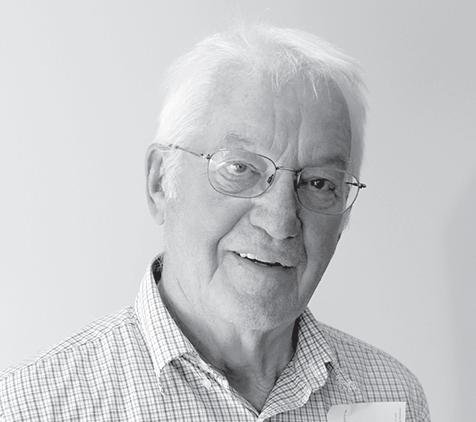
The National Fisherman photo collection was donated to Penobscot Marine Museum in 2012 and can be viewed online through the museum’s website, penobscotmarinemuseum. org. The Penobscot Marine Museum is located on Route 1 in Searsport. Kevin Johnson is the museum’s photo archivist.
observer
A paddling partner remembered Sharing a tent revealed depth of friendship
BY PHIL CROSSMAN
A FRIEND, Jack Waterbury, was a former military pilot and had retired to the island a few years earlier. Charming but woefully disorganized and chaotic, he continually misplaced things.
Many years ago, when in his 50s, he was my date on a canoeing trip with two other couples on Lobster Lake, just west of Mount Katahdin. Each day he struggled to keep up. Well, he was, after all, years older than the rest of us and, if he was failing, we certainly didn’t want to call attention to it.
If, on the other hand, his canoe was taking on water, he’d surely alert us. So we simply didn’t paddle as aggressively as we might have.
That night we pulled our boats ashore and made camp, built a fire, cooked some steaks, had several beers, told stories, and sang songs. Eventually we turned in.
One half of one of those other couples snores like a freight train. He and his long-suffering companion were in the next tent (too close). Jack and I lay reading, hoping the snoring would stop or that his other half would smother him, so we’d all be able to rest. But it continued and I couldn’t sleep.
Jack offered to help and at first, I was afraid he was going to rub my back or sing to me. Instead, he crawled out to his kayak and reached in under the bow. He didn’t find what he was looking for, not on the first try, but instead pulled out a circular saw. Grumbling, he set that aside, reached in again and this time retrieved a little metal toolbox and a selection of socket wrenches.
Quite frustrated, he pulled out a chain saw. I marveled at his having paddled around all day—where did he put his feet?—with all that unneeded weight. Then, no less a marvel, he found what he was looking for and returned to the
tent with a book of poetry by Robert Frost. He sat next to me reading poems till I fell asleep.
A few years ago, the phone rang around midnight. It wasn’t tourist season; there was no one at the motel who might have locked themselves out of their room. Jarred out of a sound sleep I wondered, during the brief interval between hearing the ring and picking up the receiver, who this might be.
My fear was that it was a certain ne’er-do-well who has called at about this time of night in the past, demanding, and irrepressible. It was not. It was Jack, by then elderly and a little fragile. He’d stepped outside to fetch a little firewood but fallen and couldn’t get up.
He had a wrist monitor and pressed it, alerting an answering service which, in turn, called me; I was apparently the first name on the list of several to call in such an instance.
I pulled on some clothes and went right out, eventually found him lying in the dirt behind his house, and helped him to his feet. He was very unsteady and the first step he took landed on my own foot whereupon we both went down. My second effort was more successful, and I got him into the house.
The next day, when he went to the fish house and to join the evercaustic bunch of local guys who have welcomed him for post work-day drinks and comradeship for years, he got the sympathetic reception he’d come to expect. One of them allowed that if it had been him who’d been called, he’d have come with a shovel.
Phil Crossman lives on Vinalhaven where he owns the Tidewater Motel. He may be reached at philcrossman.vh@gmail.com.
25 www.workingwaterfront.com may 2023
A photo shot in December 1972 shows a fishing boat and Coast Guard vessel in peril at the mouth of Casco Bay.
PHOTO: NATIONAL FISHERMAN COLLECTION, PENOBSCOT MARINE MUSEUM
art of the waterfront
Stephen and David Etnier: A legacy of place
BY CARL LITTLE
IN HIS AUTOBIOGRAPHY Overworked Guardian Angel, published posthumously in 2009, the painter Stephen Etnier (1903-1984) paid homage to the stretch of the Maine coast around South Harpswell where he lived and which he haunted for a good part of his life. This “series of coves and inlets with fingers of land jutting into the sea,” he wrote, create “the loveliest of vistas.”
Etnier considered Harpswell Neck to be one of those “magic configurations,” the result of “the roll of massive glaciers thousands of years ago.” Here, he declared, houses and boats could “coexist” and become “a comfortable family of land-lovers and sealovers, each with its own privacy; each with its own special individuality.”
Proof of Etnier’s passion for this place can be found in his paintings. Over the years he painted at multiple points along that coastline, in love with the particulars of wharves and sheds, boats and buoys. As seen in the photograph by Robert Solotaire from the 1960s, he would set up his easel on a dock and get to work.
Writing about Etnier’s work in 1989, critic Edgar Allen Beem stated that “no one in Maine” had lived closer to the sea, “literally and figuratively speaking,” than this painter. He made special note of the quality of light in the canvases.
Father and son dedicated to the working waterfront CHASLE21.PLT 2/10/2021
“Inside Haskell’s” (1969) underscores Etnier’s signature sense of light and his attraction to Maine’s working waterfront. The painting pays homage to a simple and iconic arrangement of docks and sheds bathed in late day sunlight. The “inside” in the title refers to the locale: inshore of Haskell’s Island in the distance.
He painted at multiple points along that coastline, in love with the particulars of wharves and sheds, boats and buoys.


Etnier’s son David, a photographer, knows the spot intimately as he used to leave from that same shore as a sternman starting in high school.
“It is on the northerly side of Potts Point in Harpswell,” he explains, “facing west.” He recalls that a handful of lobstermen, including several members of the Bibber family, worked out of that cove.


David Etnier has always thought his father was a pioneer painter of the working waterfront, taking up the subject “decades before the phrase was coined.” Indeed, it is hard to find a Stephen Etnier Maine coast scene that doesn’t feature some aspect of its fishing culture. A profound appreciation for Maine’s working waterfront passed from father to son. While in the
Maine legislature, David Etnier brought forth the constitutional amendment to allow for “current use taxation” for working waterfront properties. The amendment passed in the House and Senate but failed the needed statewide vote. The second time around, with Dennis Damon sponsoring, the amendment passed.
26 The Working Waterfront may 2023 GET H A ULIN’ Jonesboro, ME (207) 434-5791 Portland, ME (800) 244-8727 Thomaston, ME (800) 426-4526 West Bath, ME (855) 848-6027 BROOKSTRAPMILL.COM Enter to win a $100 gift certificate by visiting our website or “Like” us on Facebook. BROOKS TRAP MILL & MARINE SUPPLIES A large selection of traps and trap kits Stop by for all your fishing and commercial boating needs
PORTLAND 207-772-6383 ELLSWORTH 207-667-9390 NEW LOCATION IN PORTLAND: 84 COVE STREET MARINE SAFETY CONSULTING LIFE RAFT INSPECTIONS Life Raft Sales and Inspections Inflatable Boats • Charts Books • Navigational Tools
2:43:50 PM
Robert Solotaire's photo of Stephen Etnier at Moody’s Lobster on Ash Point in the 1960s.
PHOTO: COURTESY DAVID ETNIER
Etnier also proposed the legislation that created the Working Waterfront Access Pilot Program. When he became deputy commissioner at the Maine Department of Marine Resources, he put the program in place as part of the Land for Maine’s Future

initiative, using bond allocations to permanently preserve eligible working waterfront properties. By way of policy and paint, the Etniers’ legacy of preservation of place lives on, up and down the coast of Maine.

27 www.workingwaterfront.com may 2023
Islandport Press will be publishing Carl and David Little’s The Art of Penobscot Bay in the fall.
Stephen Etnier’s “Inside Haskell’s” (1969), oil on canvas.
Emma Fernald and her partner Sam Flavin of Little Cranberry Isle are diversifying their fishing business through aquaculture. With Compass Grant funds, Emma was able to purchase equipment to collect scallop spat and Sam was able to to complete his diving certification and buy cold water scuba gear.























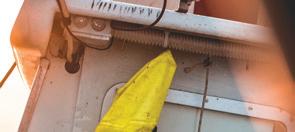






28 The Working Waterfront may 2023 Nobody finances commercial fishing like Farm Credit East. Like agriculture, the fishing industry has its own unique credit needs. And we’re proud to serve them both. No other lender offers more expertise, specialized financial products, or dedicated services to achieve your goals. farmcrediteast.com | 800.831.4230 Financing For: Boats & Trucks Real Estate Permits Bait Storage Facilities Wharves Equipment Haul Out & Repair Operating Lines OUR BUSINESS IS TO LEND YOU MONEY. OUR MISSION IS TO GROW YOUR SUCCESS. 11530_FISHING_Made in Ag_Our Business_4.9x7.35.indd 1 10/8/19 1:03 PM 800-639-2715 hamiltonmarine.com KITTERY
PROUDLY SUPPORTING OUR LOCAL FISHERMEN SINCE 1977 From the latest in marine technology to traditional time-tested products, we have everything you need to make this summer on the water a wicked good one. With your support, we are helping Maine’s fishing families through assisting small businesses, promoting aquaculture, protecting working waterfronts and Compass Workforce Grants for fishing families. 4 WAYS TO SUPPORT MAINE’S FISHING FAMILIES: 1 - Online at islandinstitute.org/join 2 - Call the Island Institute office at (207) 747-1180 3 - Mail your gift to: Island Institute, PO Box 648, Rockland, ME 04841 4 - Scan this QR code: All gifts count toward membership
PORTLAND ROCKLAND SEARSPORT SW HARBOR JONESPORT
PLEASE CONSIDER MAKING YOUR GIFT TODAY!

























 BY STEPHANIE BOUCHARD
BY STEPHANIE BOUCHARD




























 PHOTO ESSSAY BY KELLI PARK
PHOTO ESSSAY BY KELLI PARK







































































